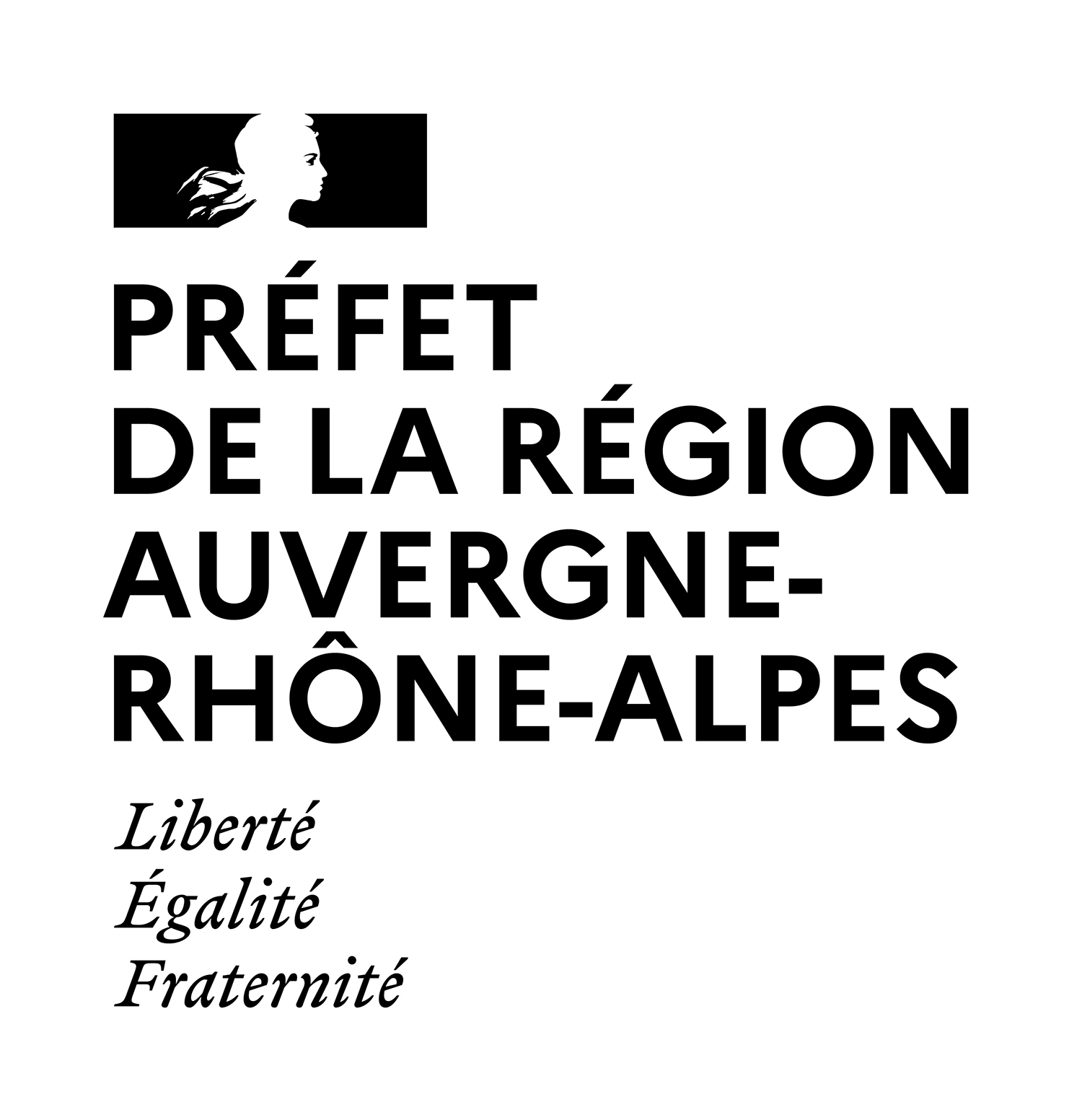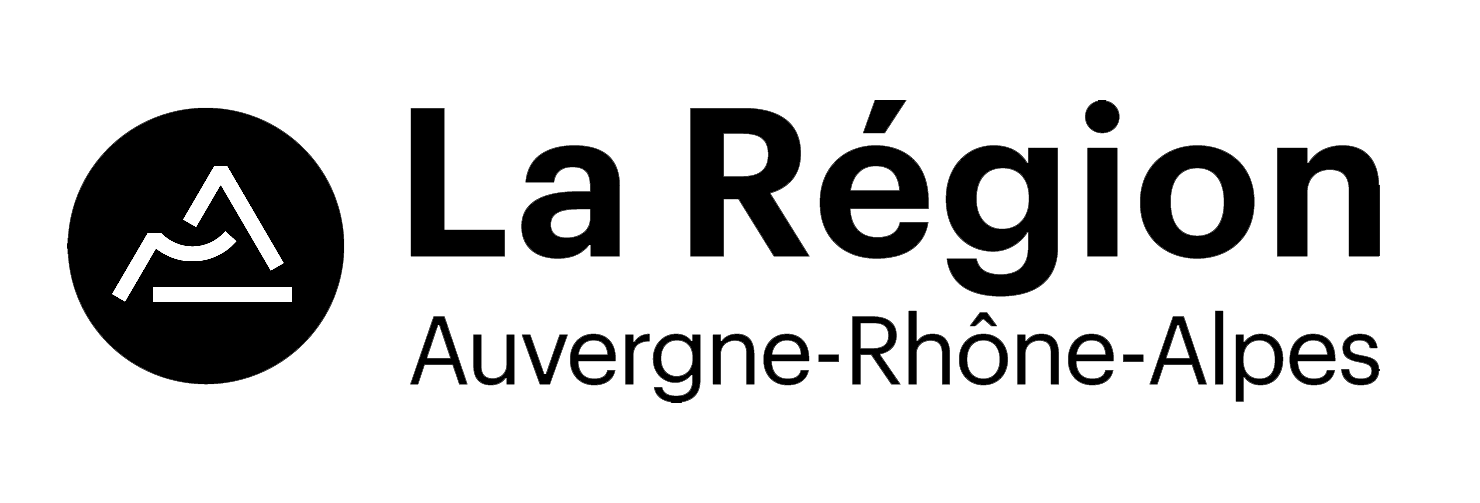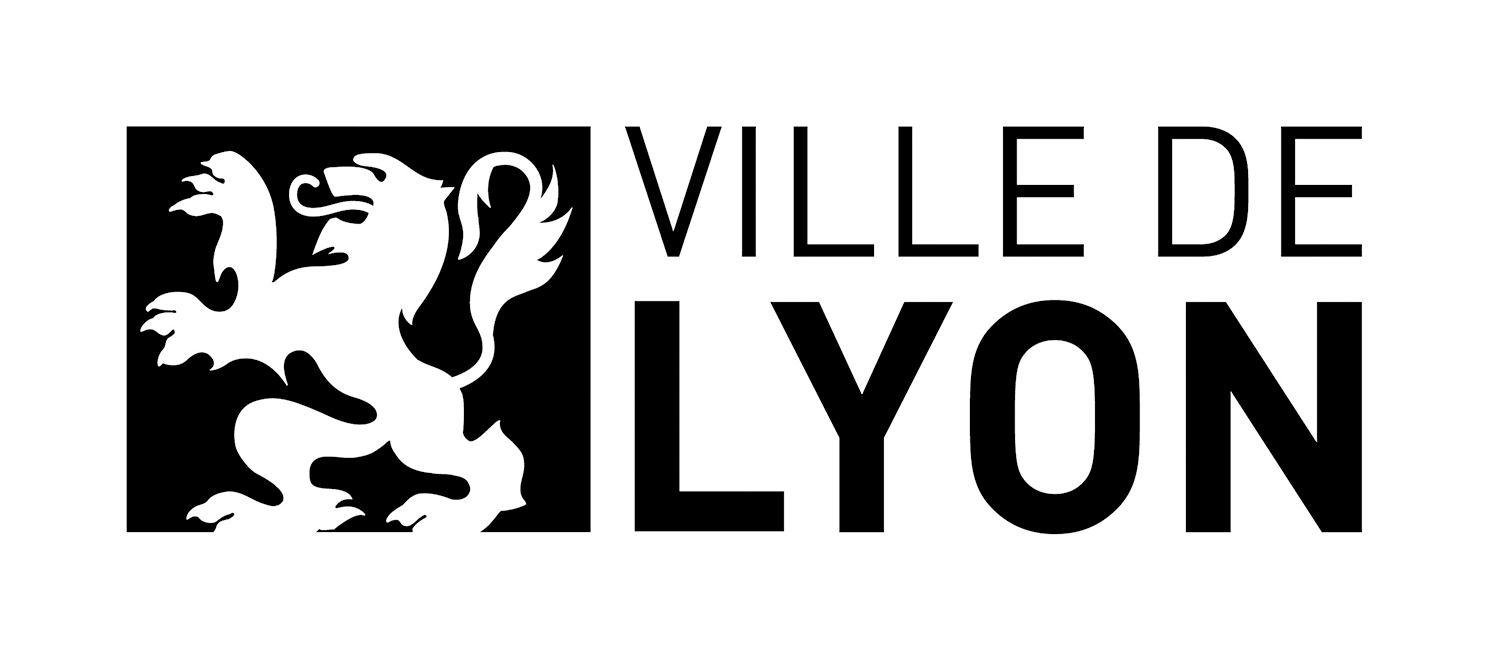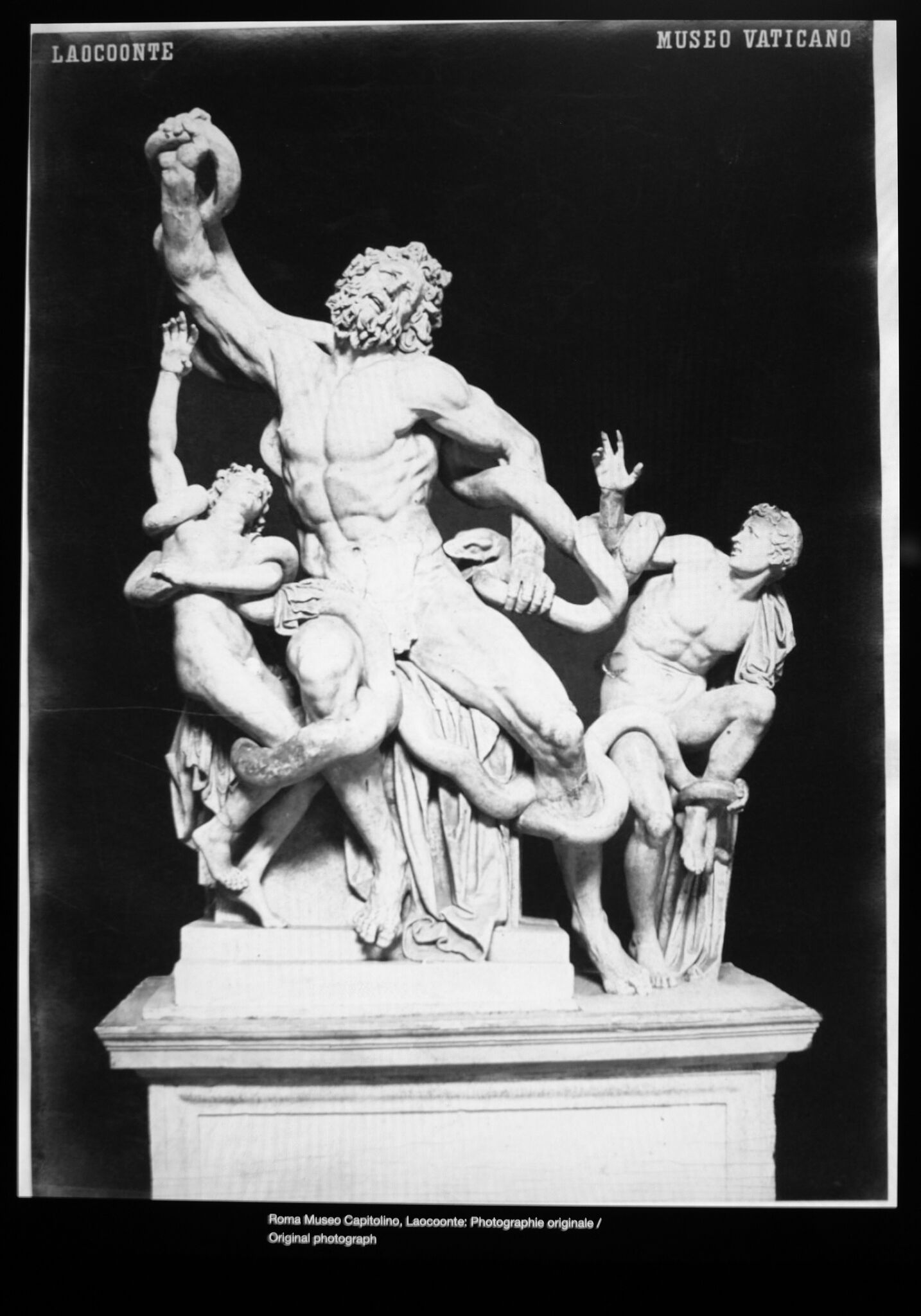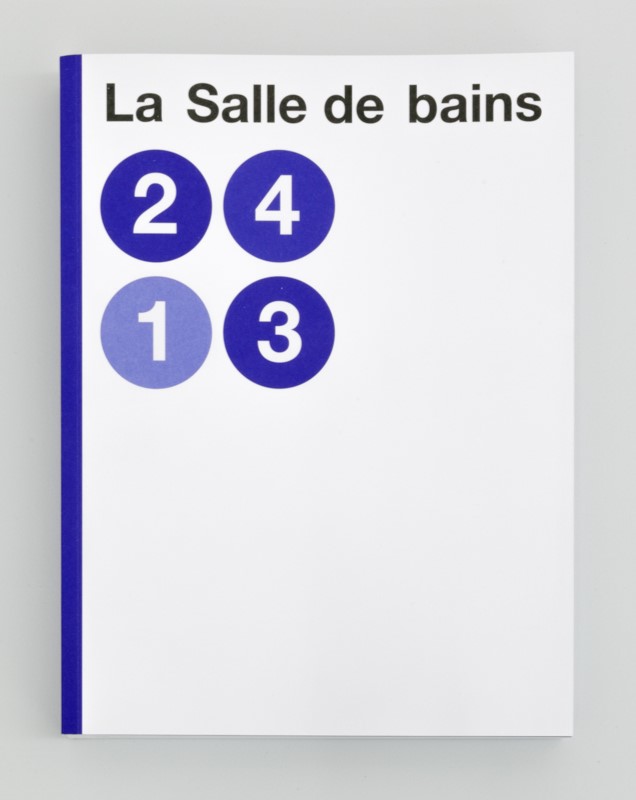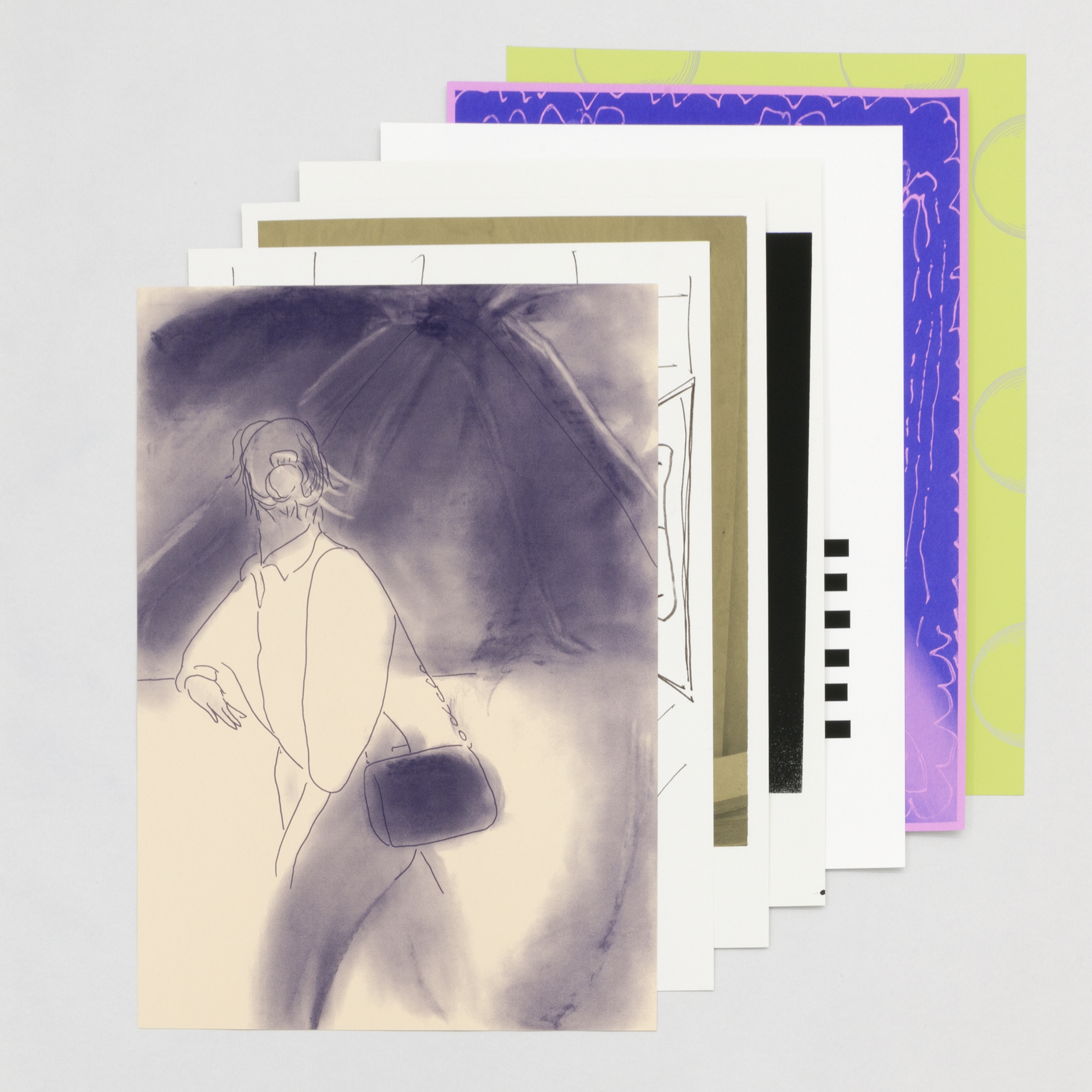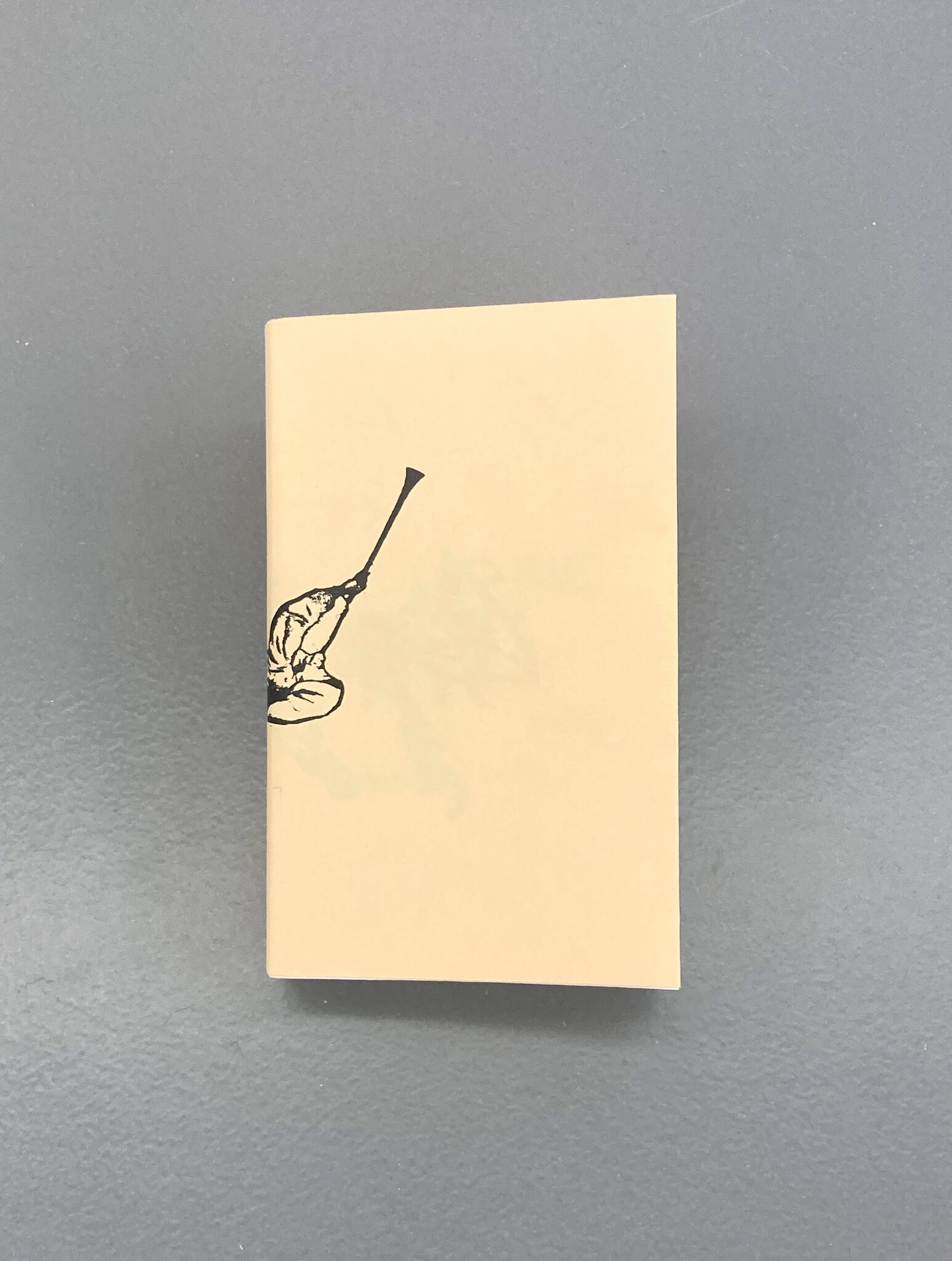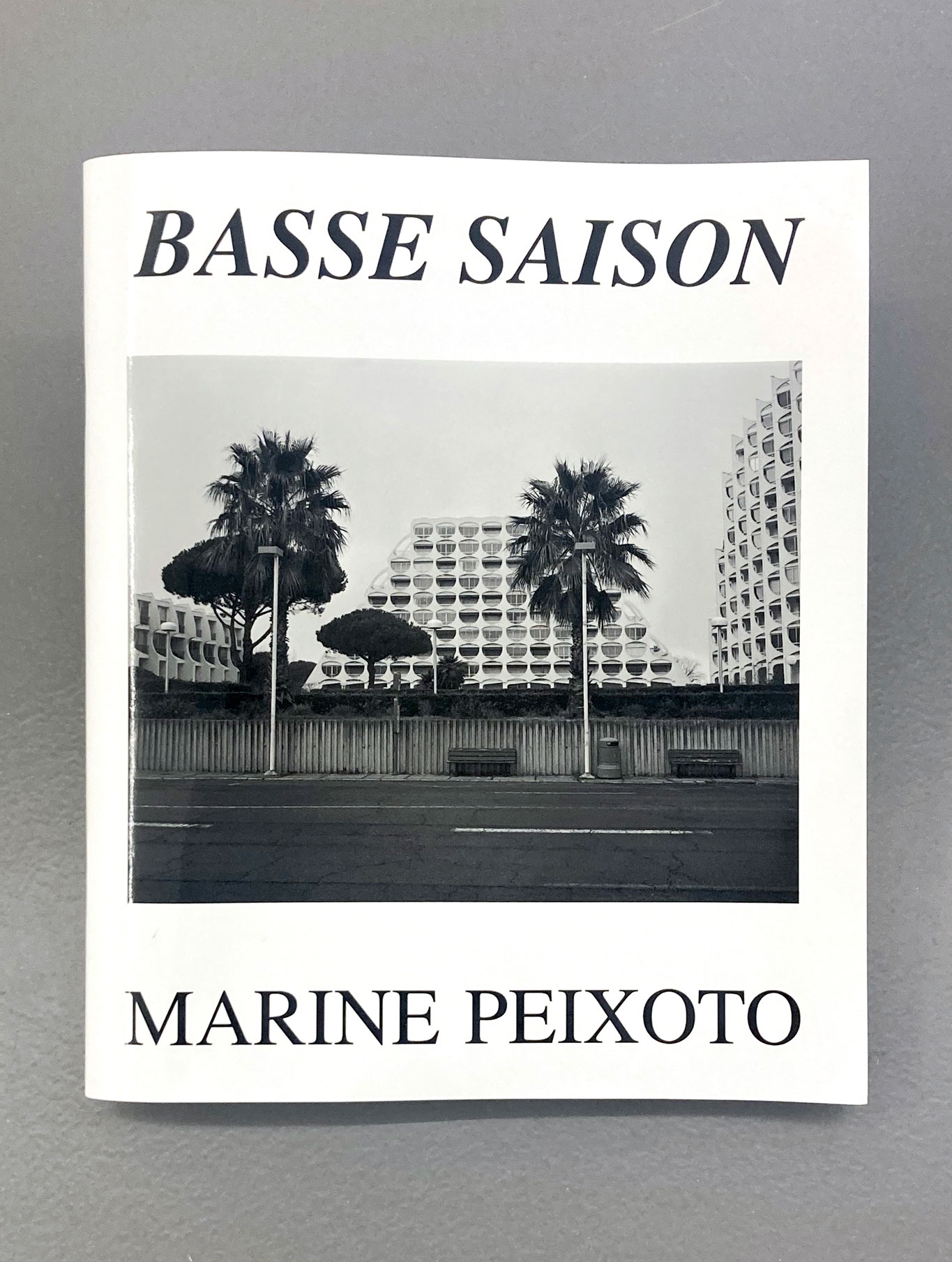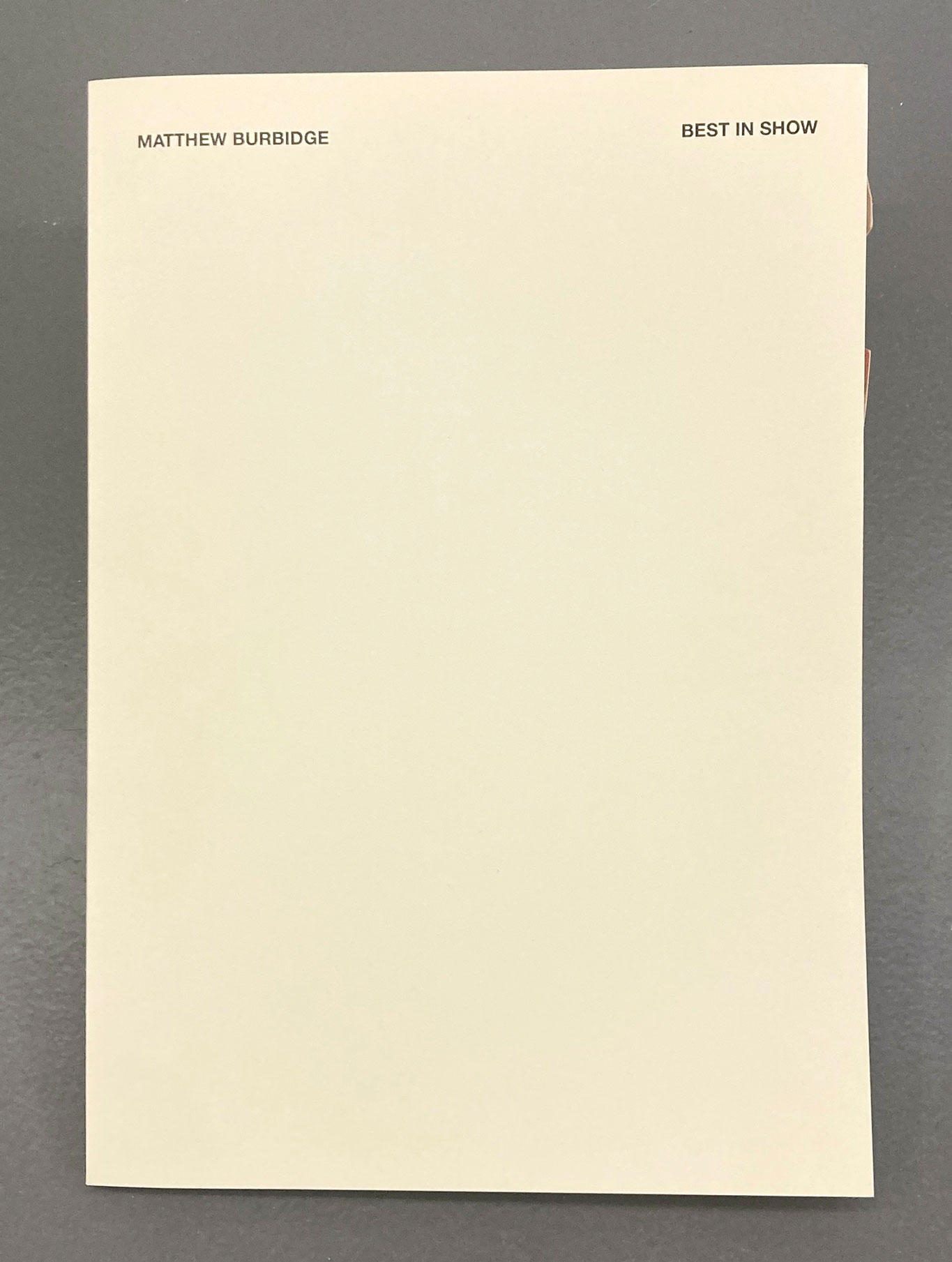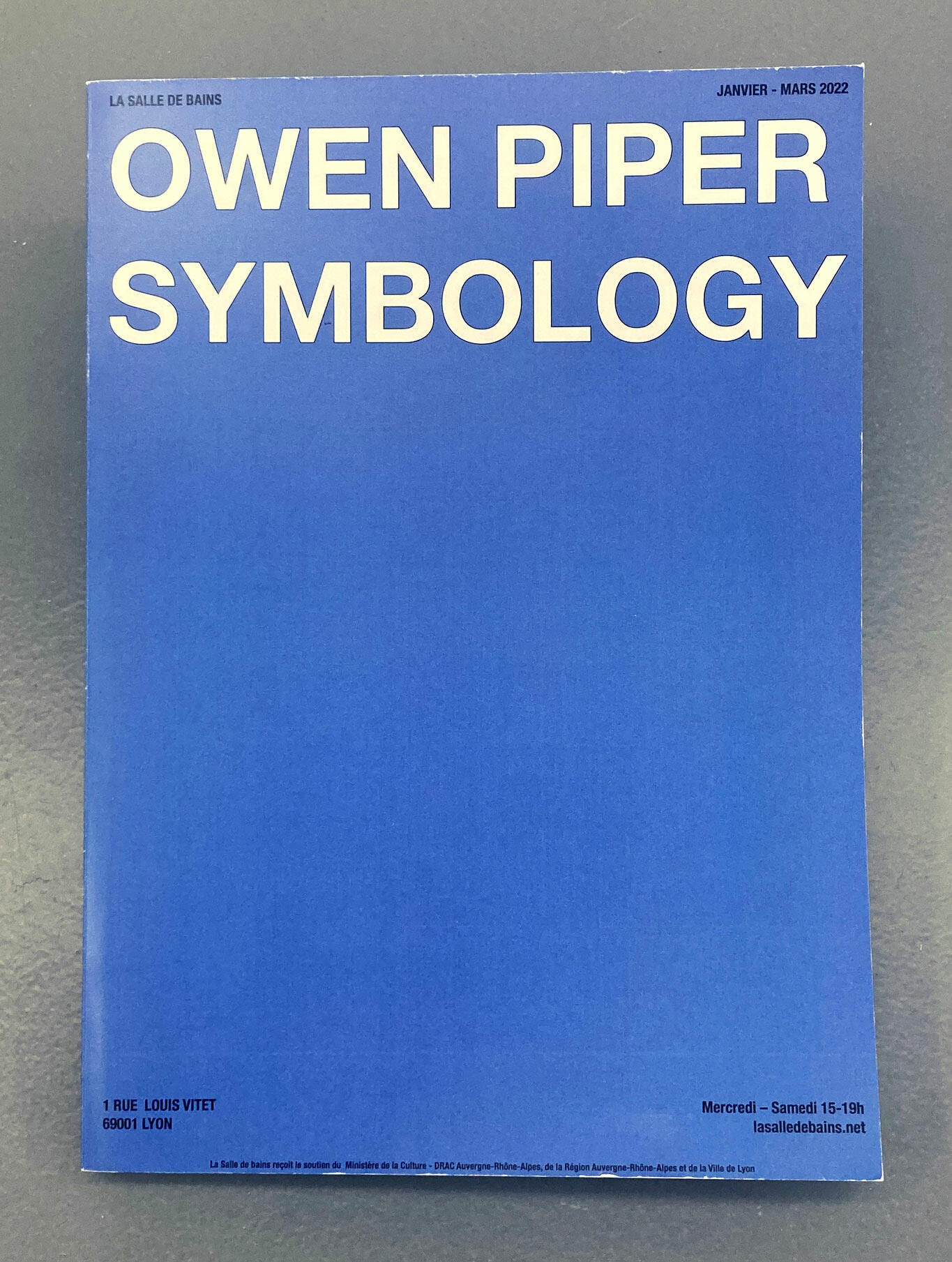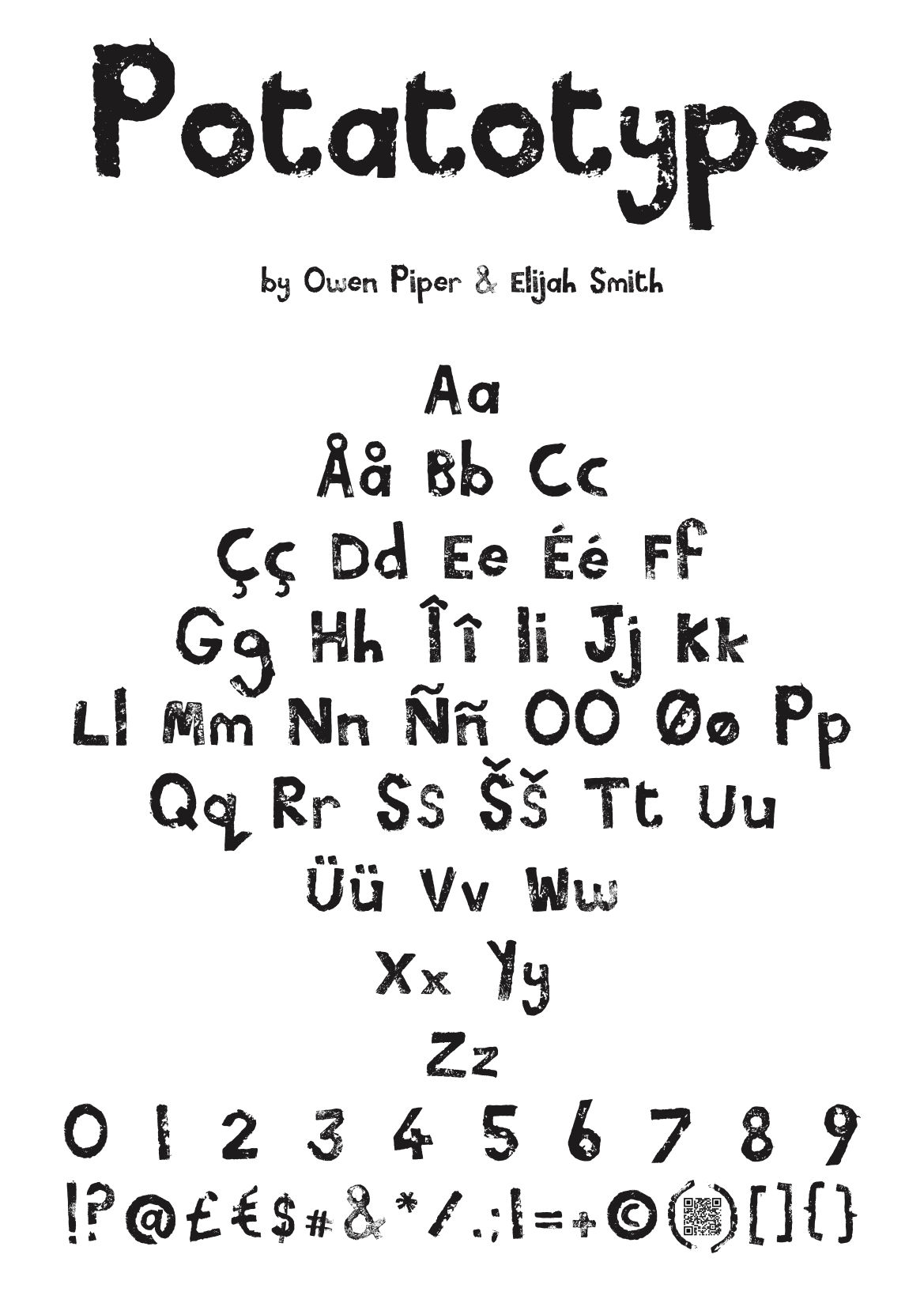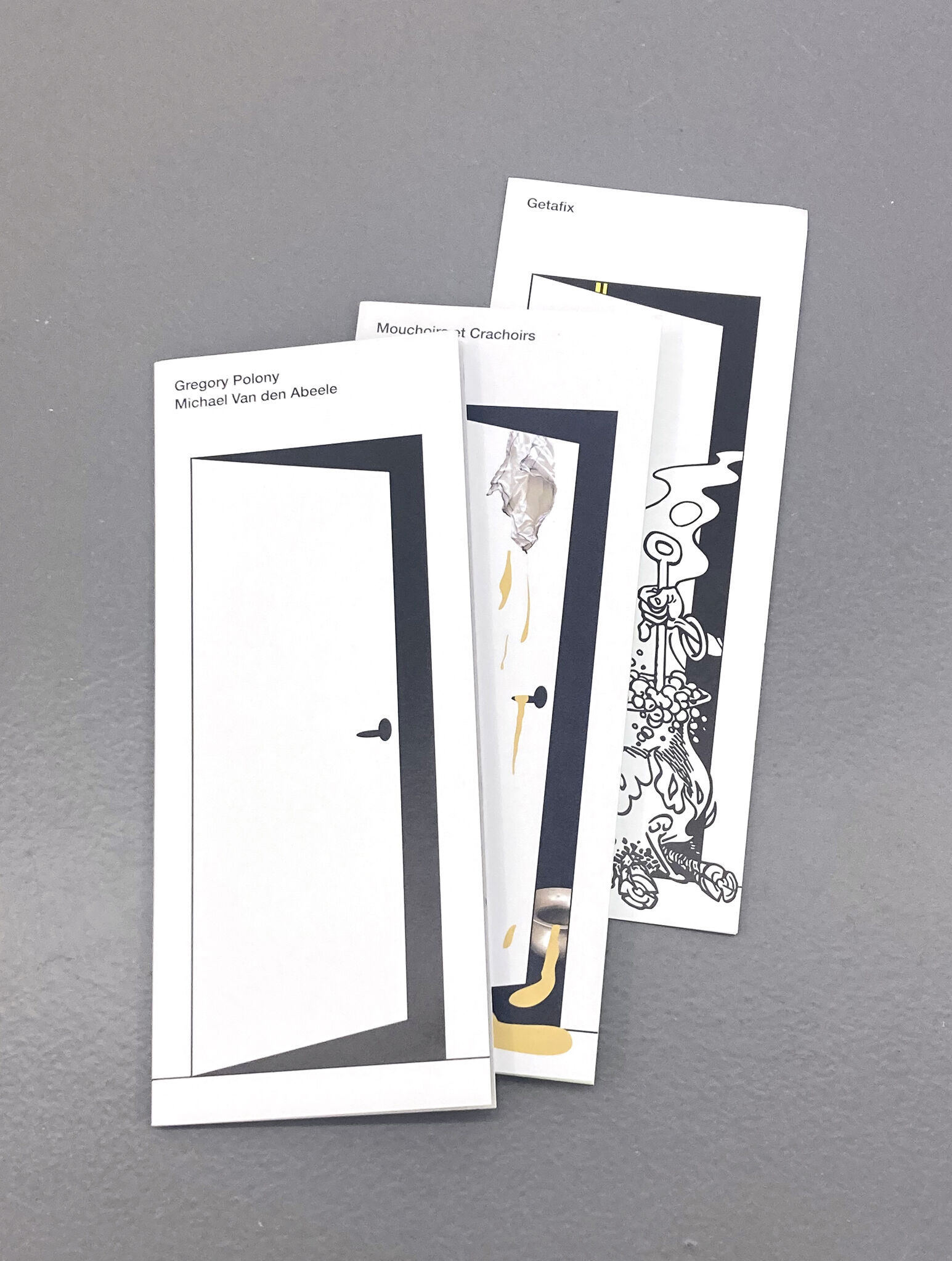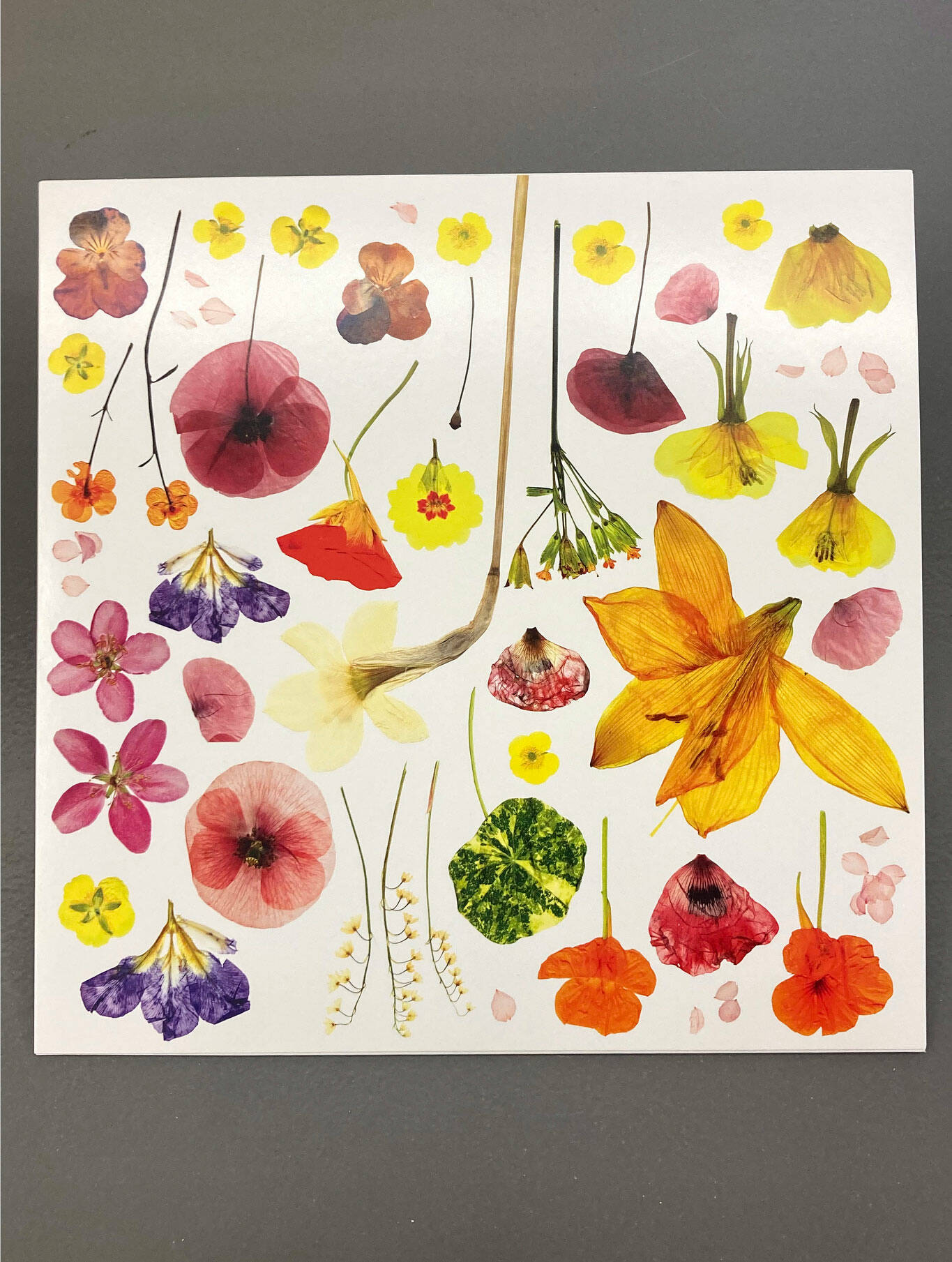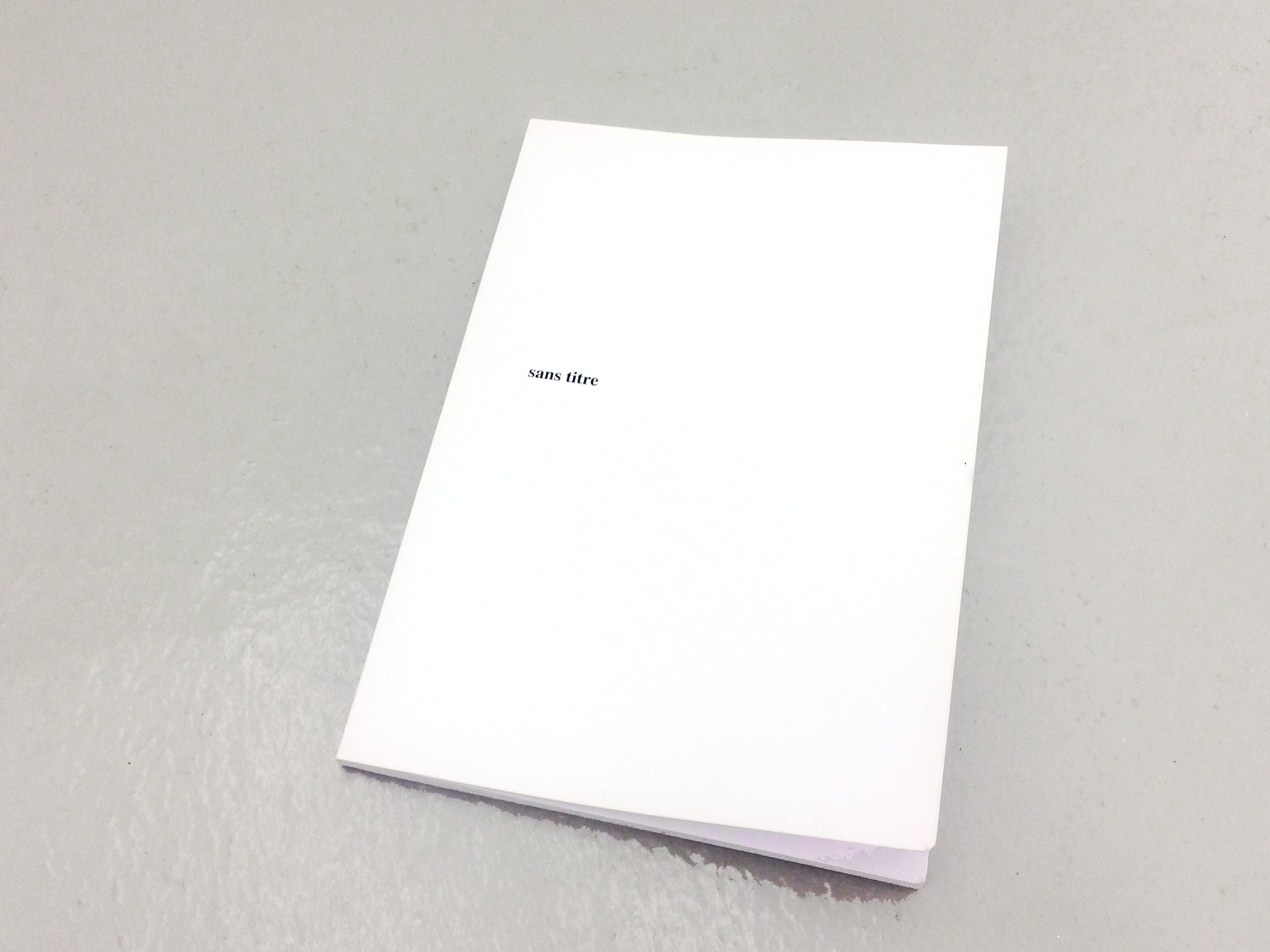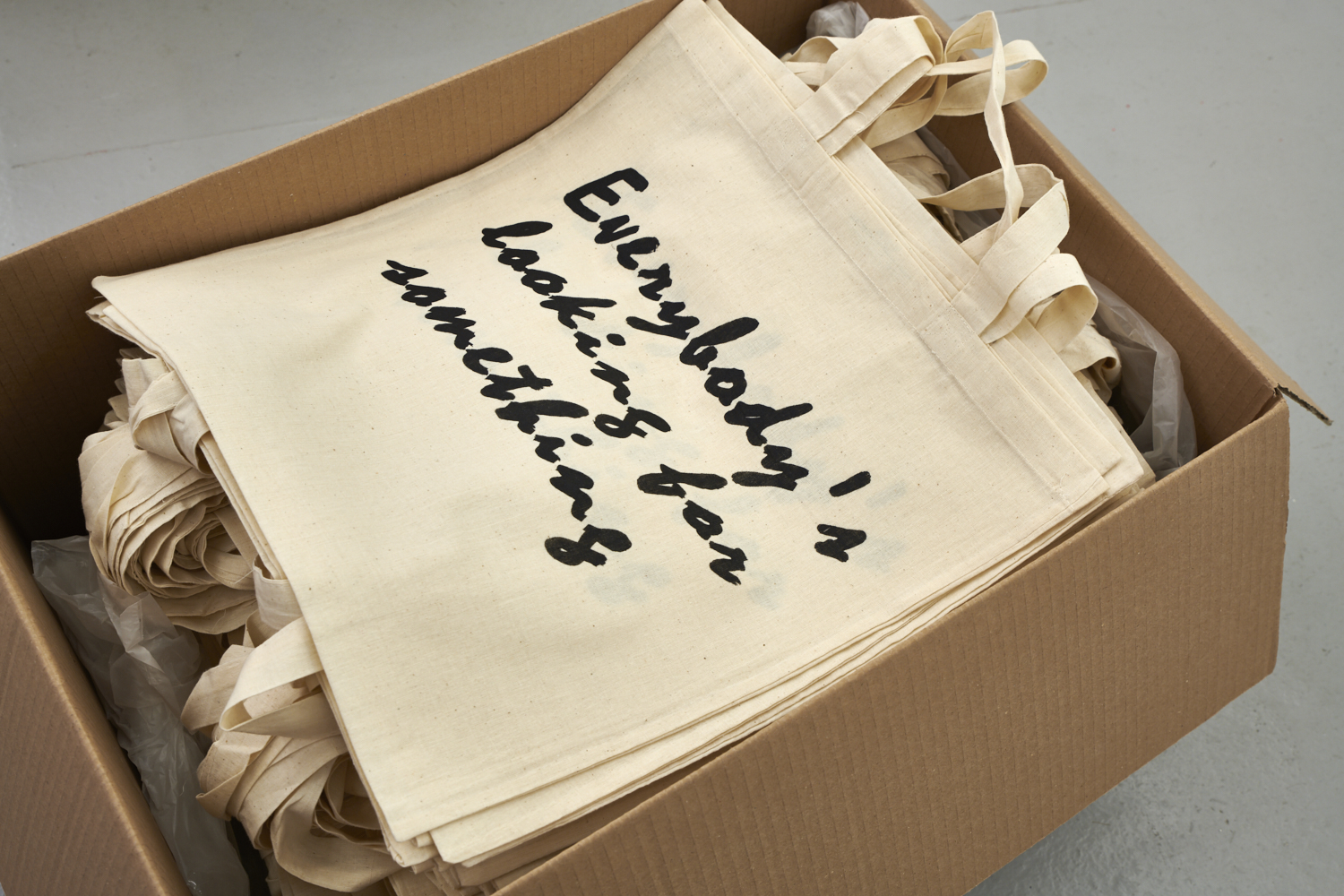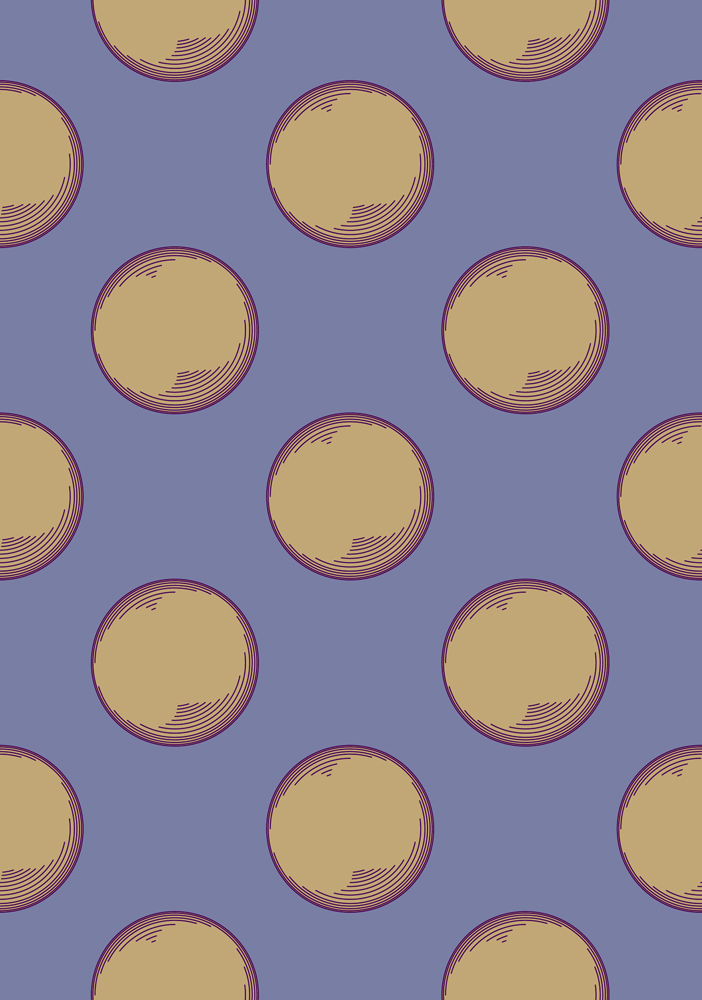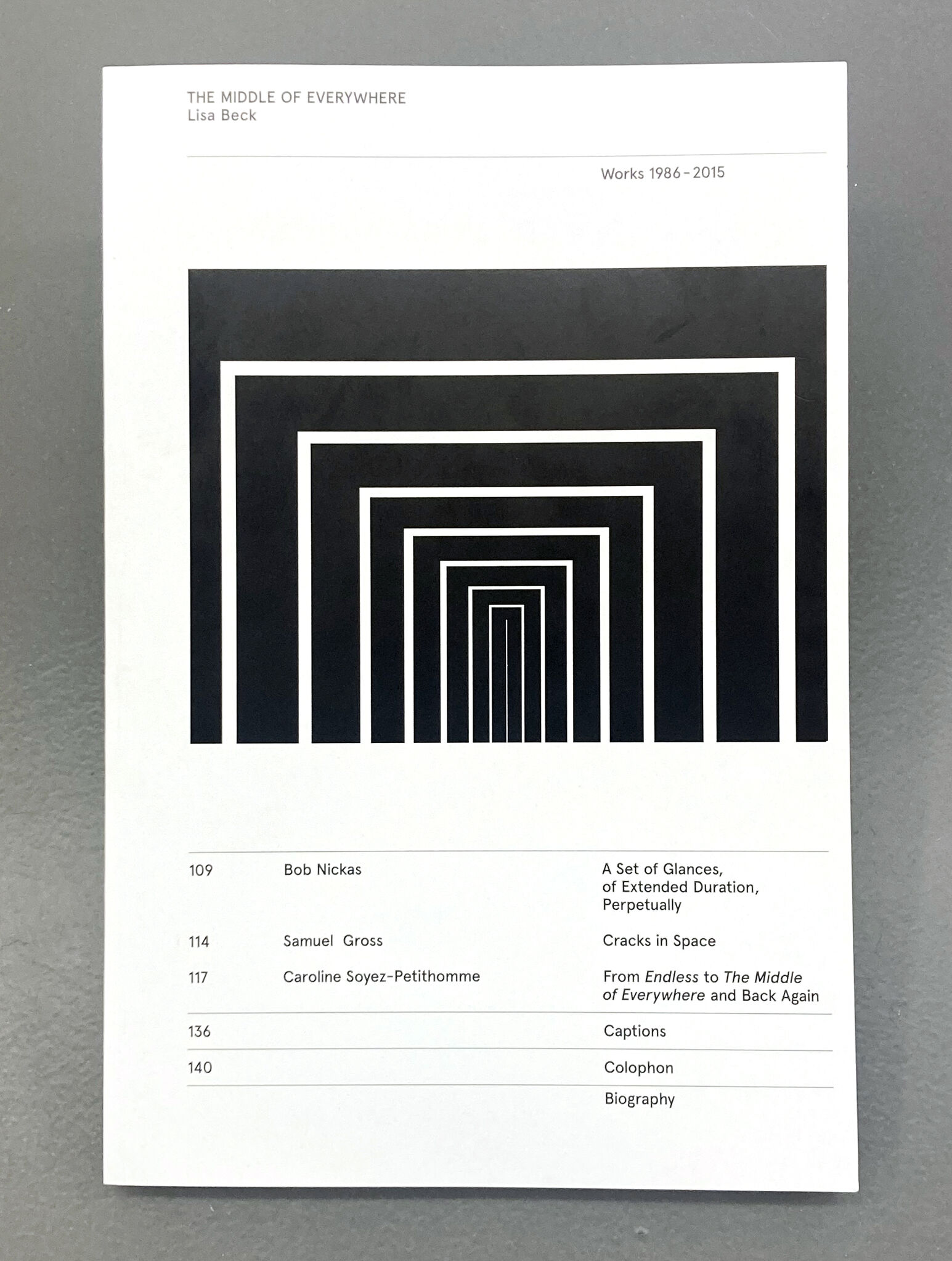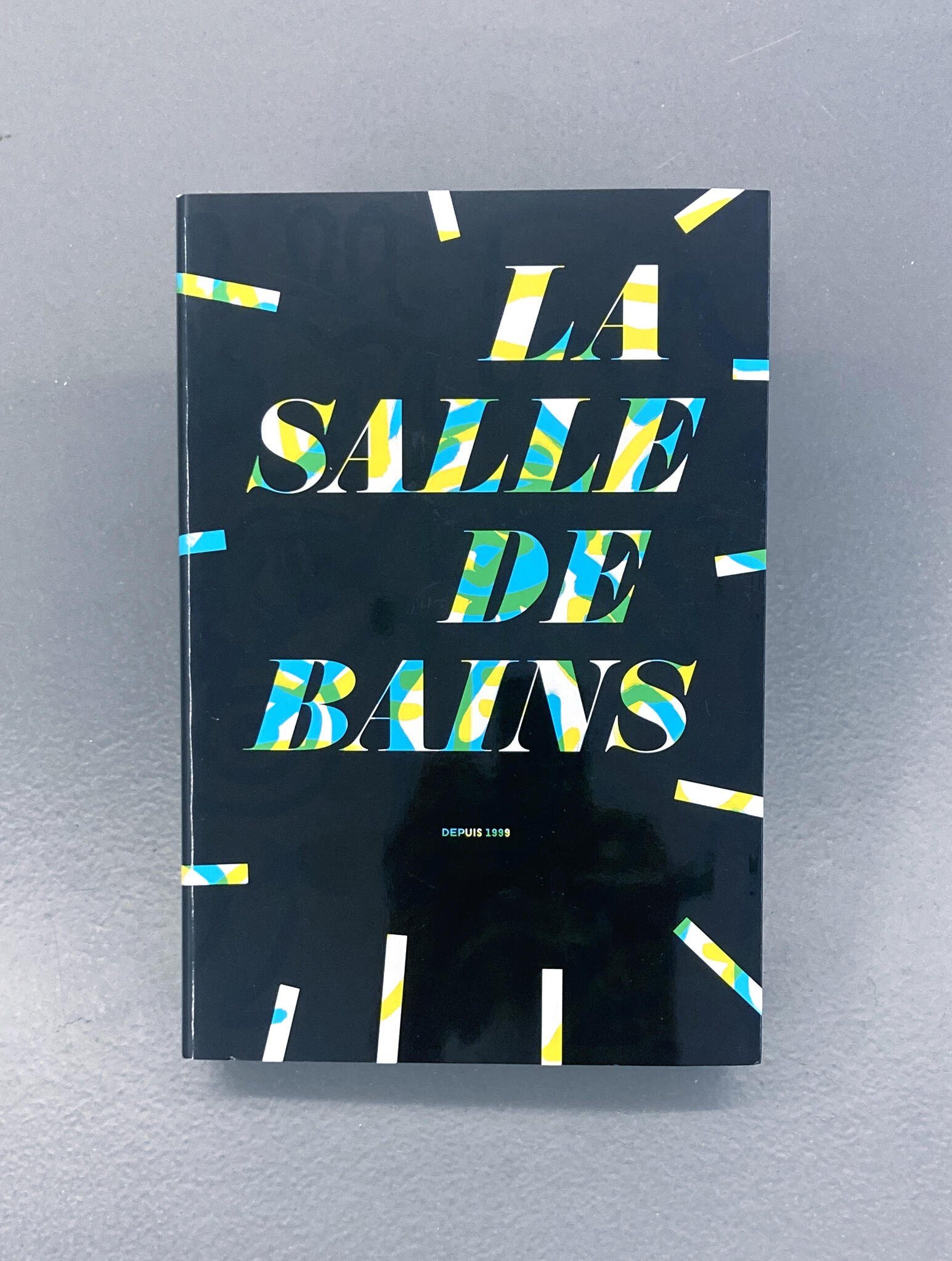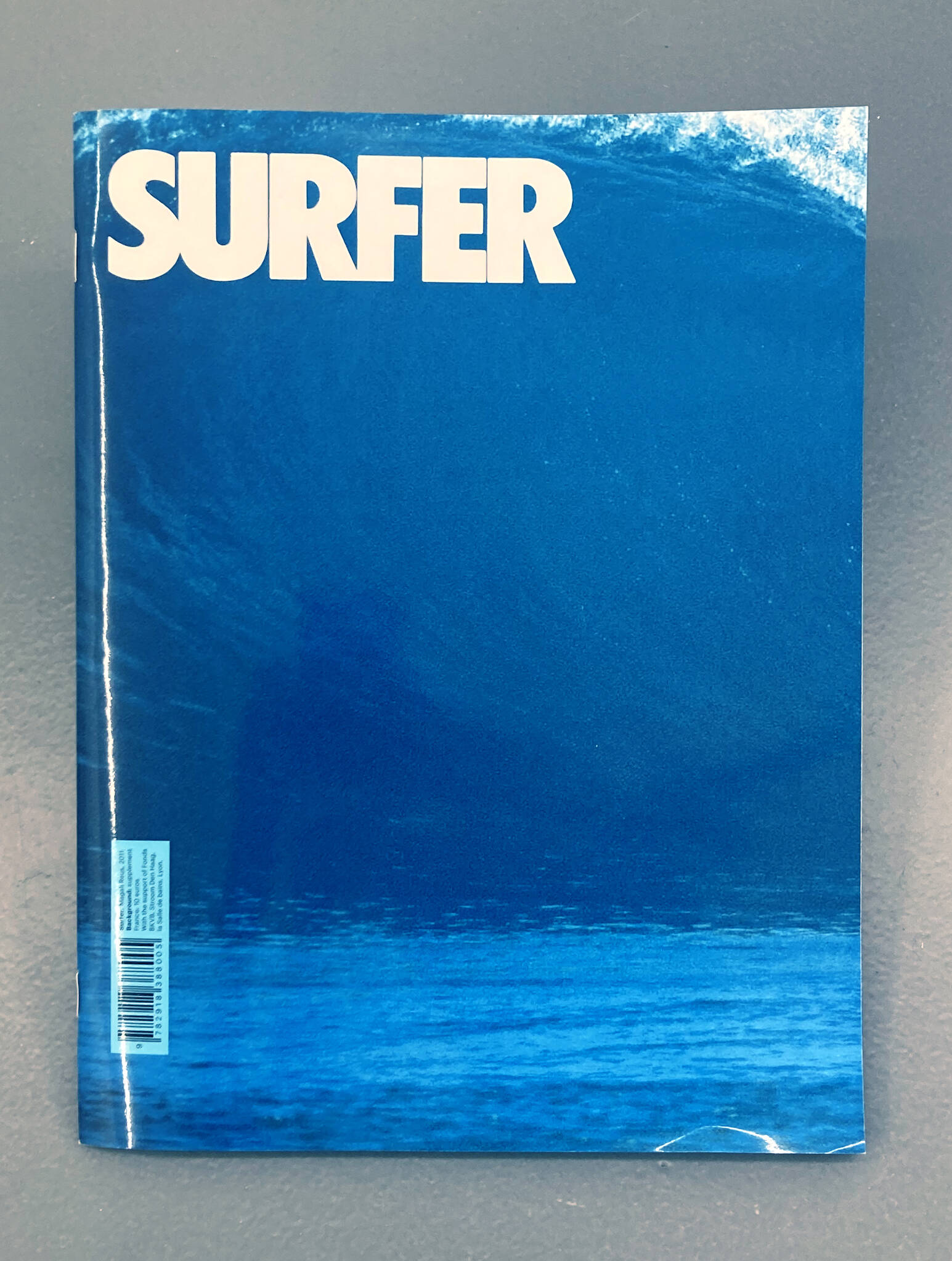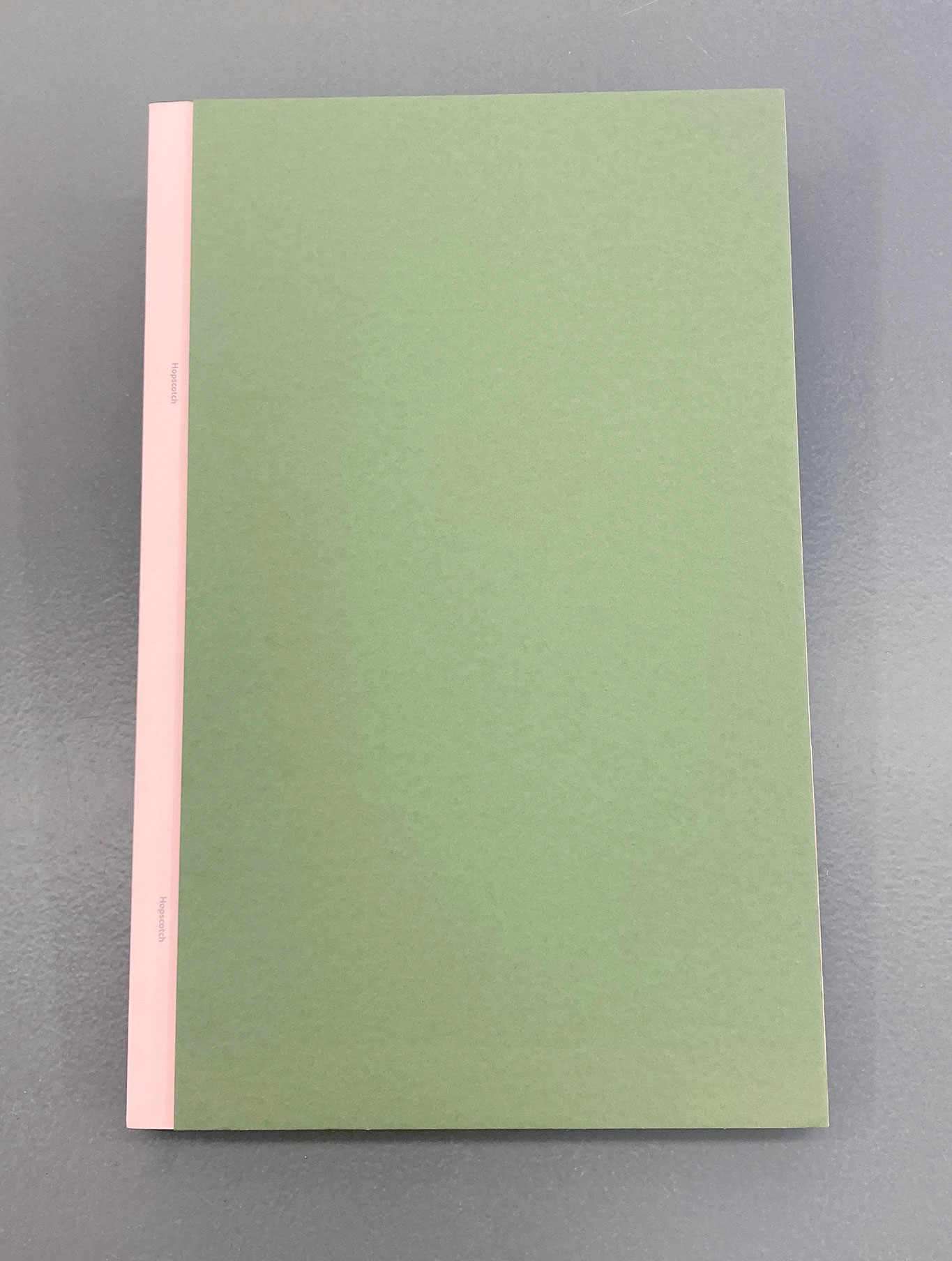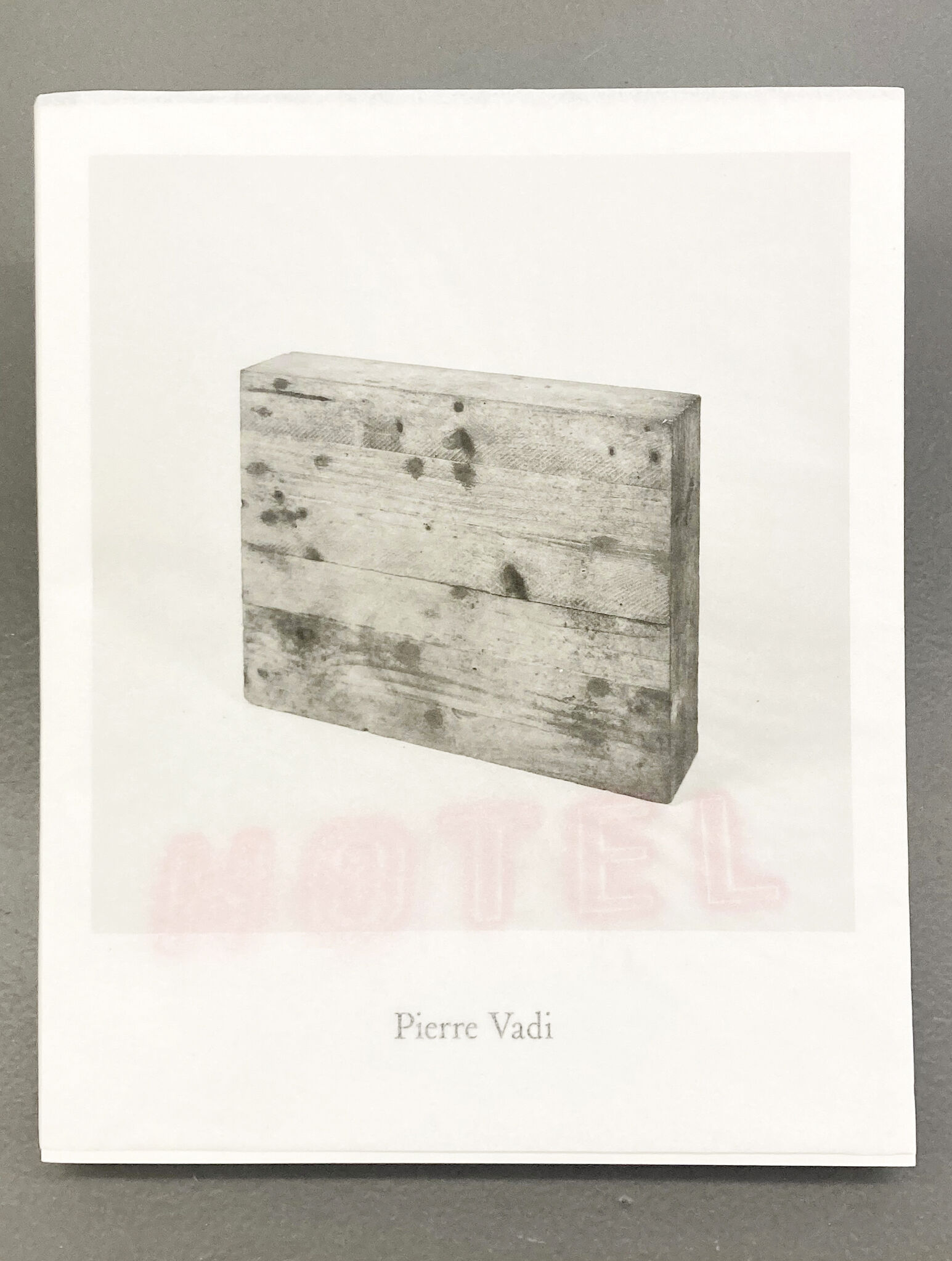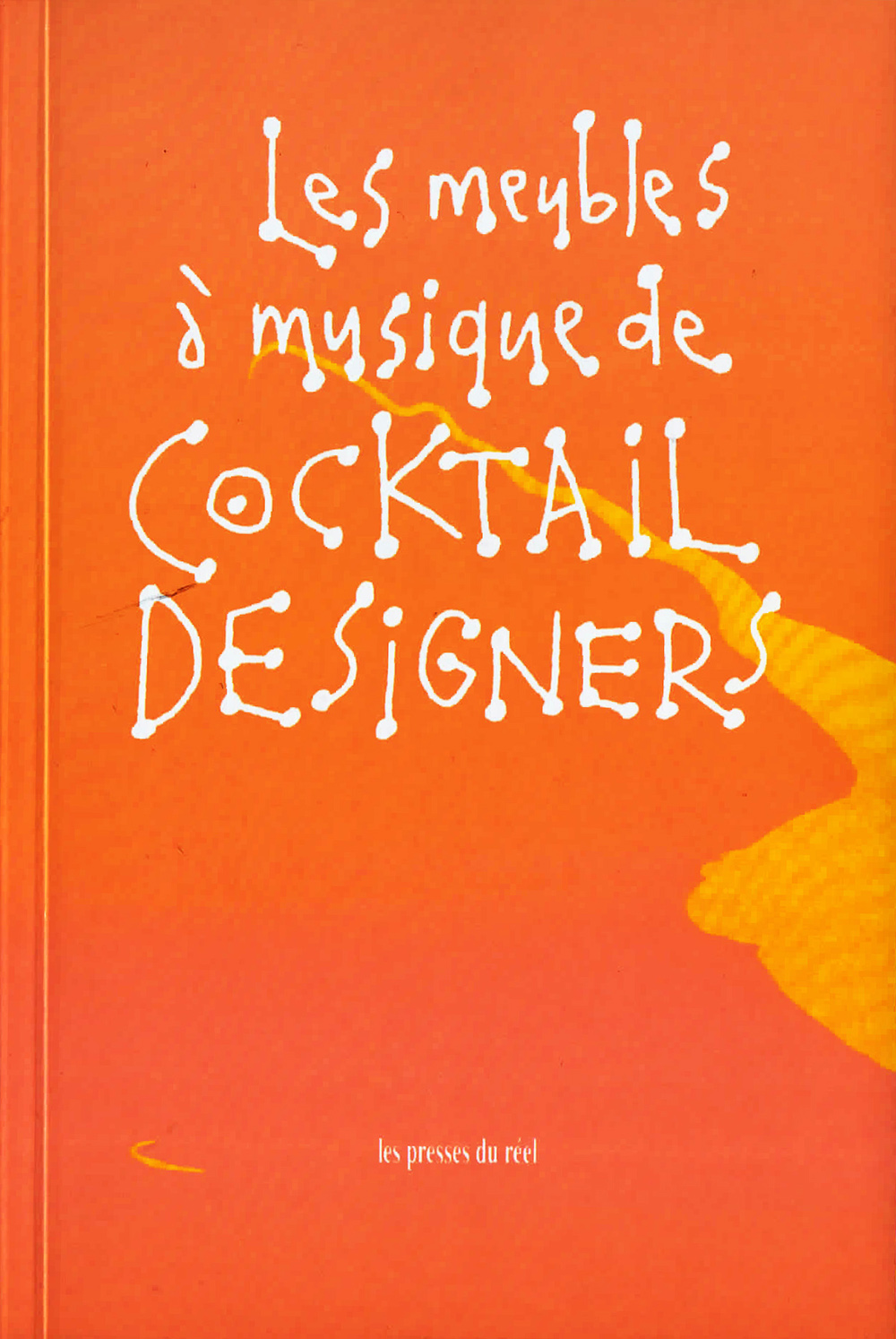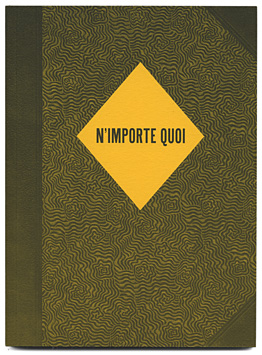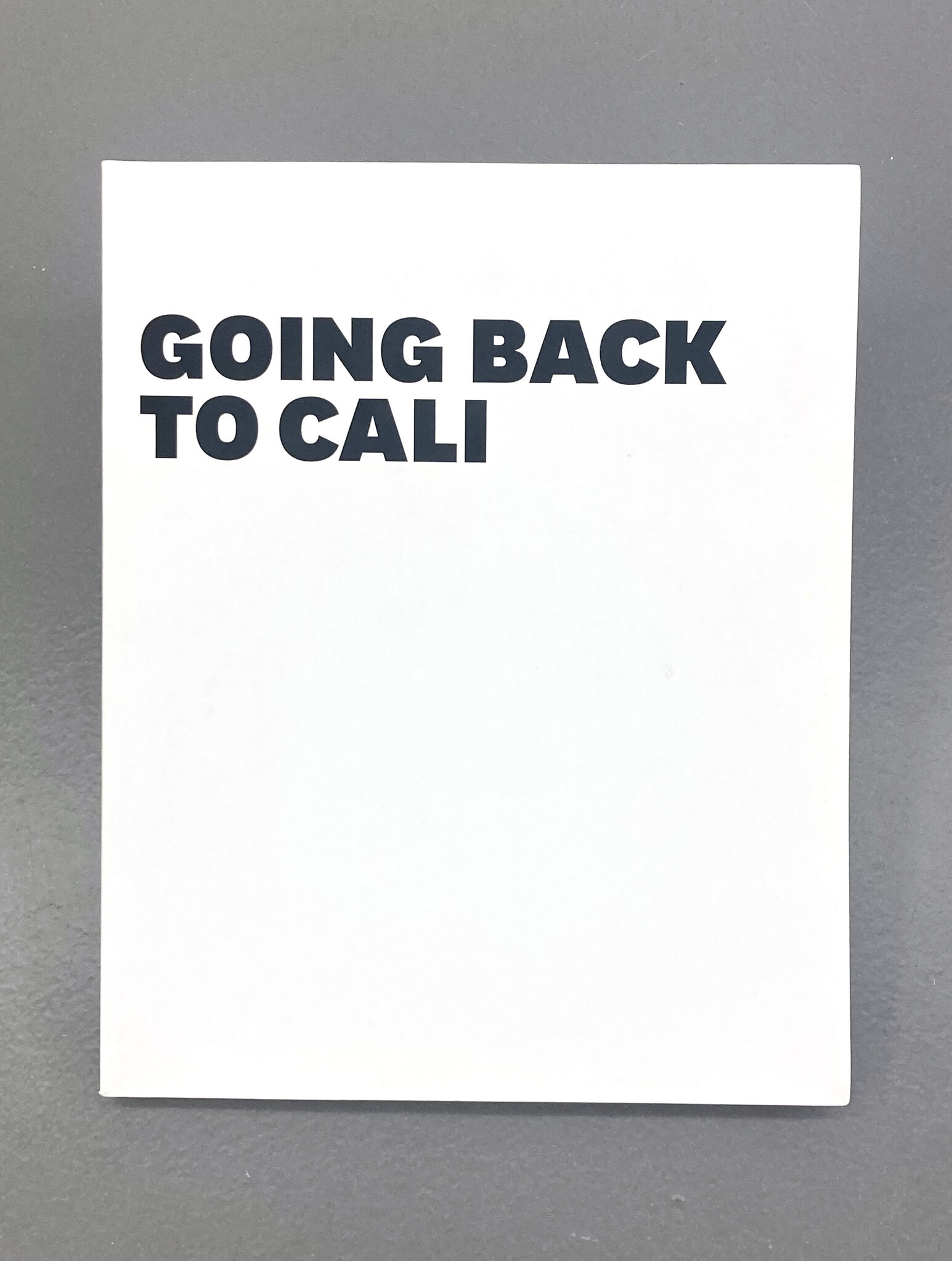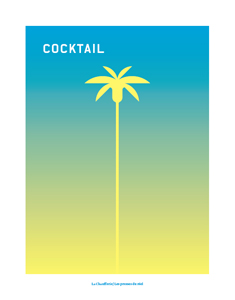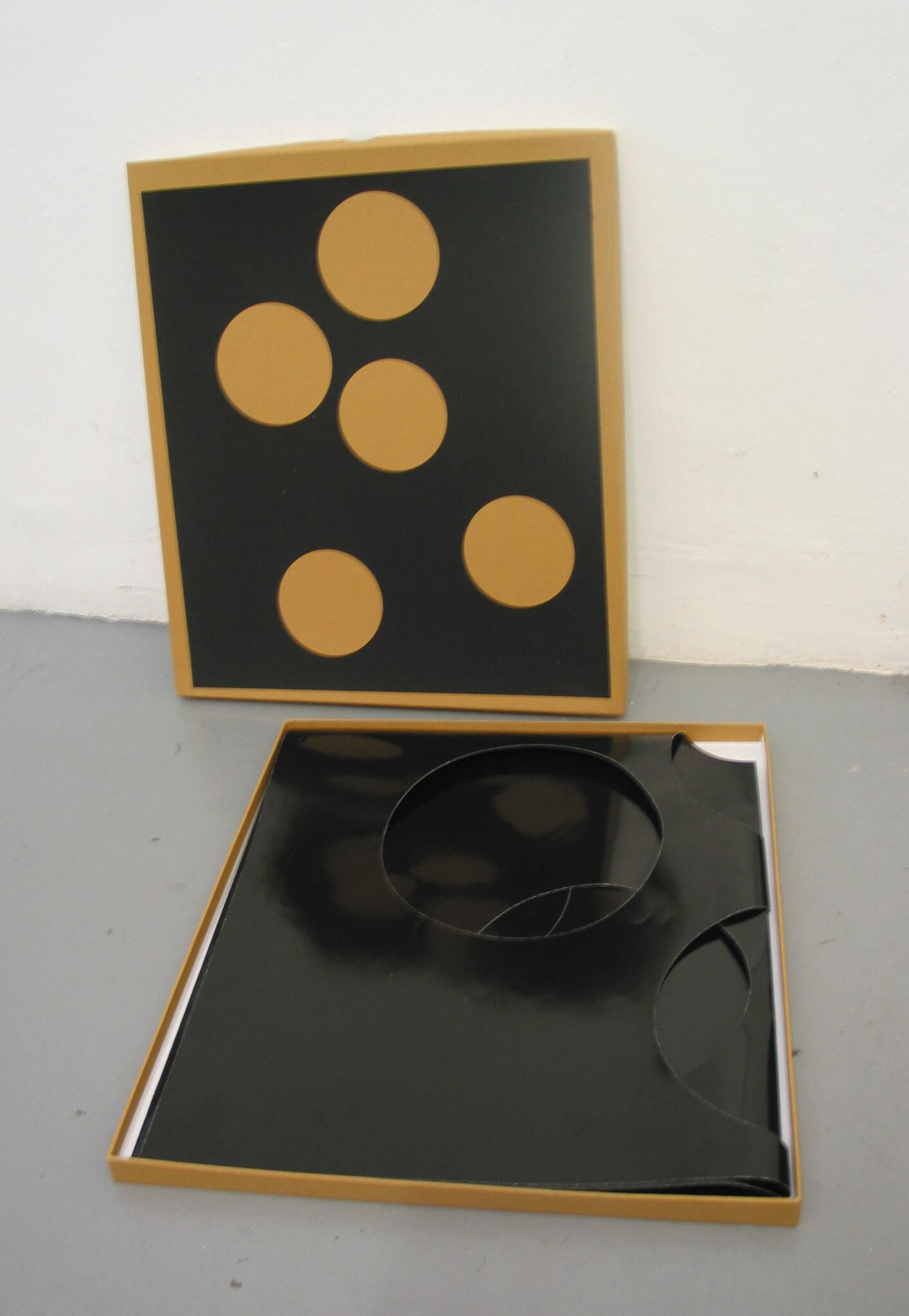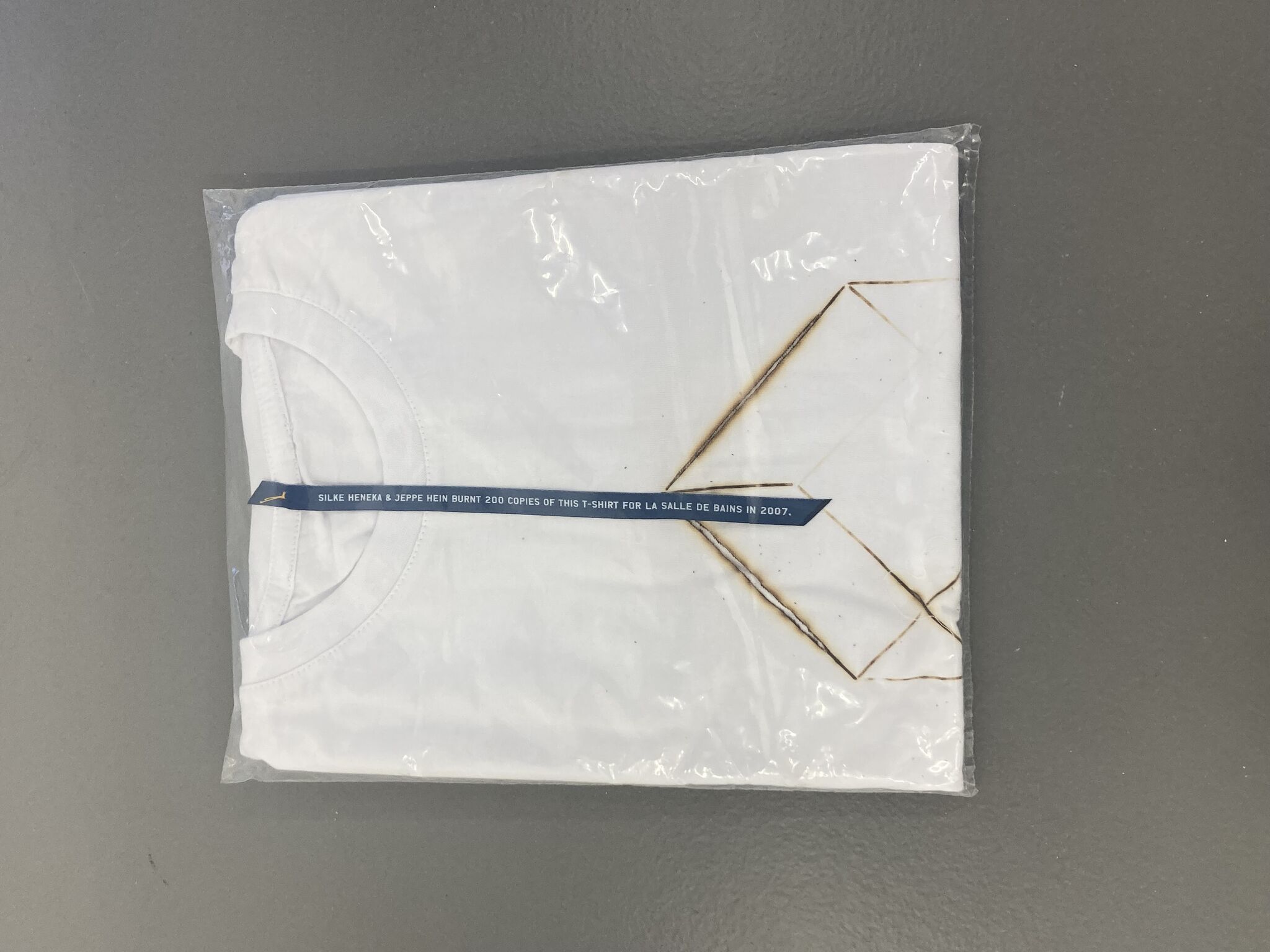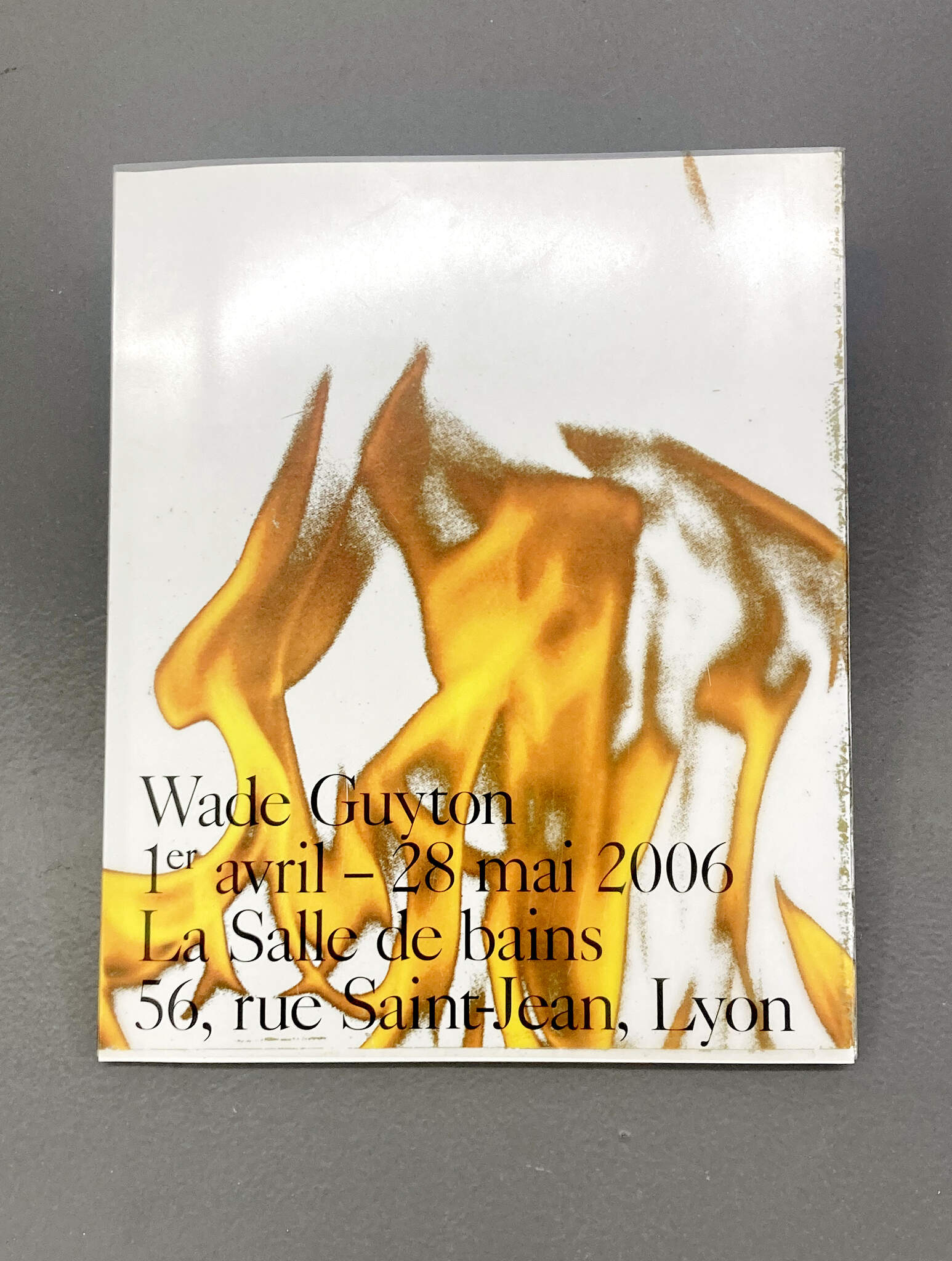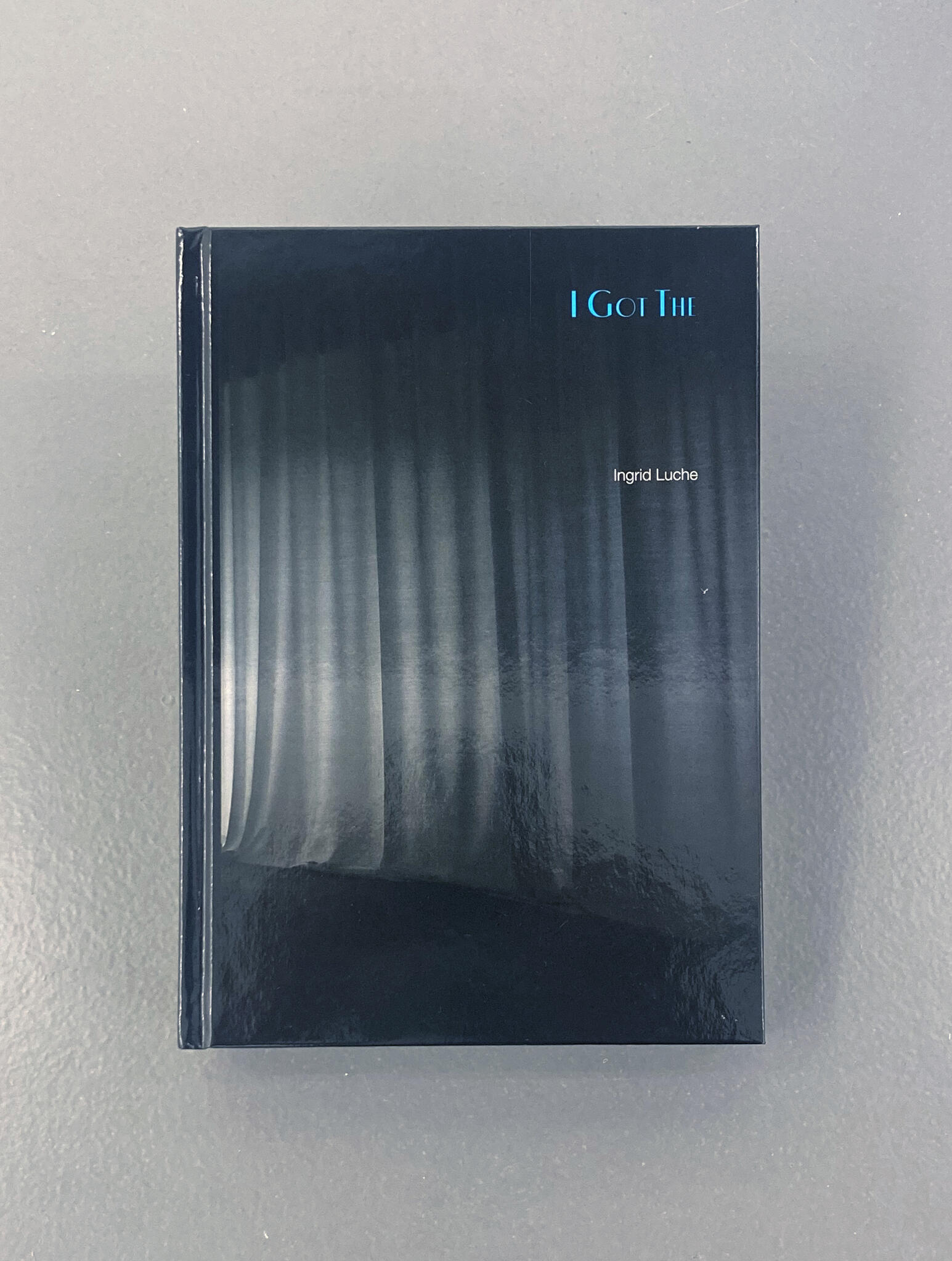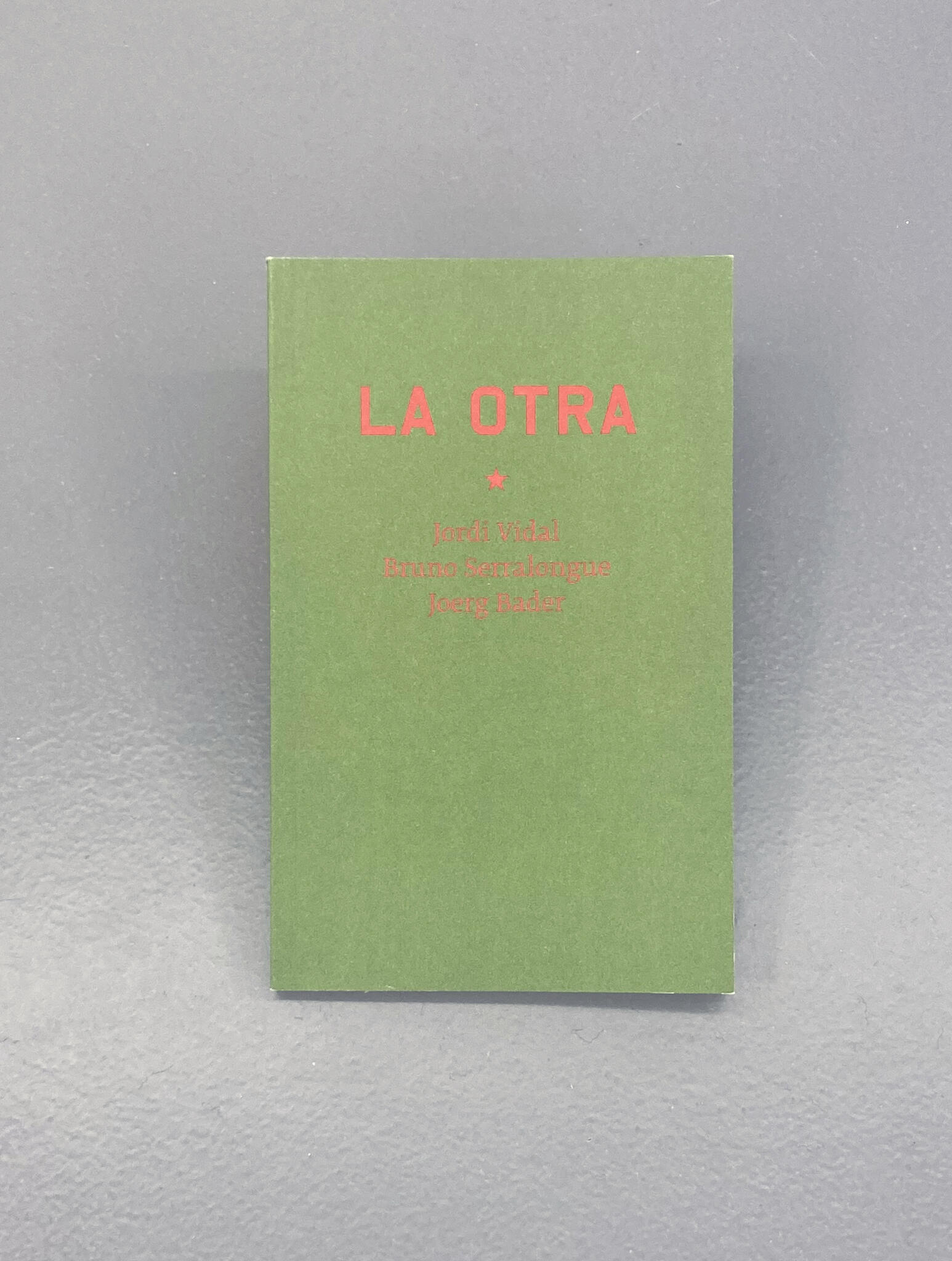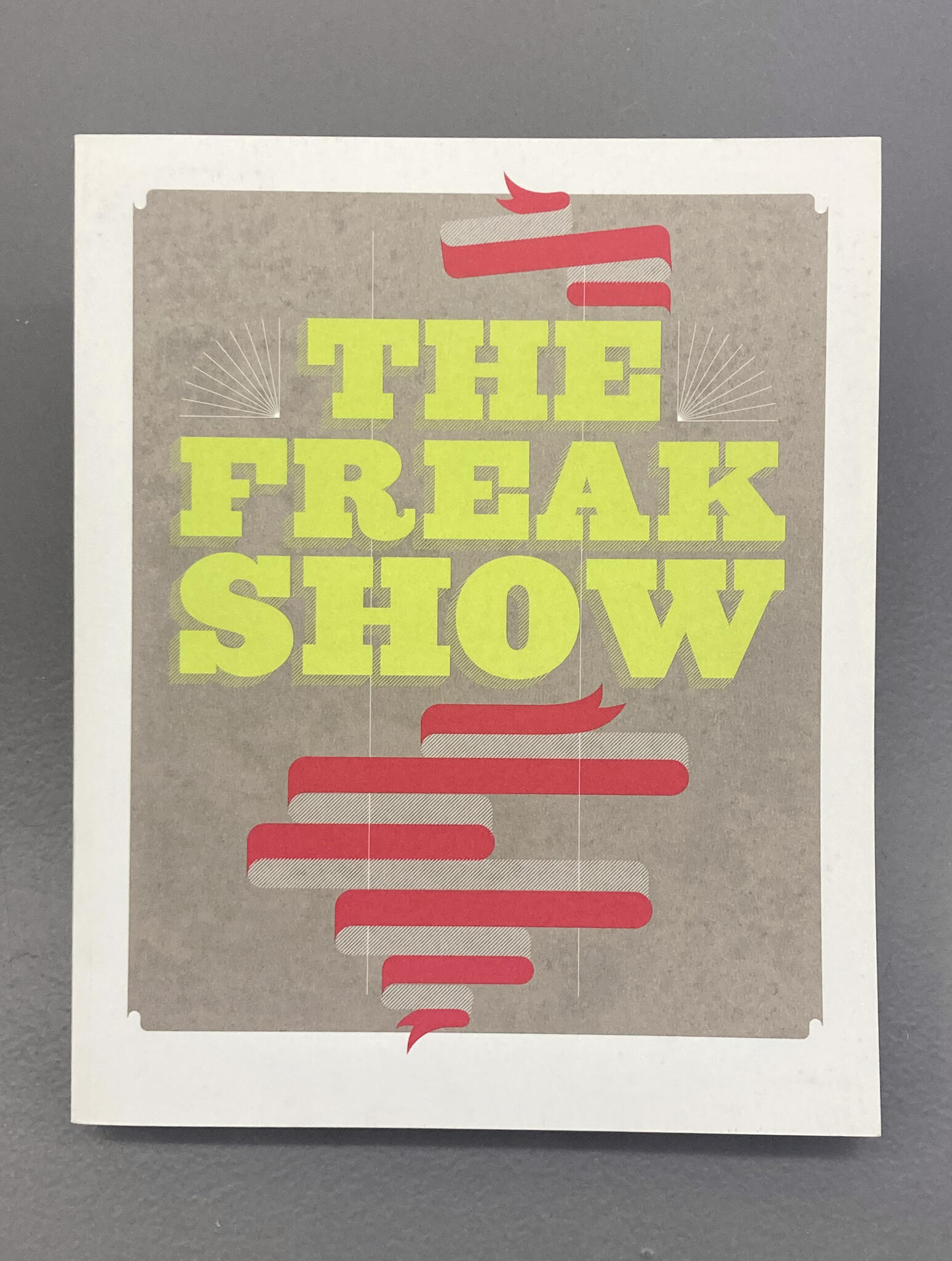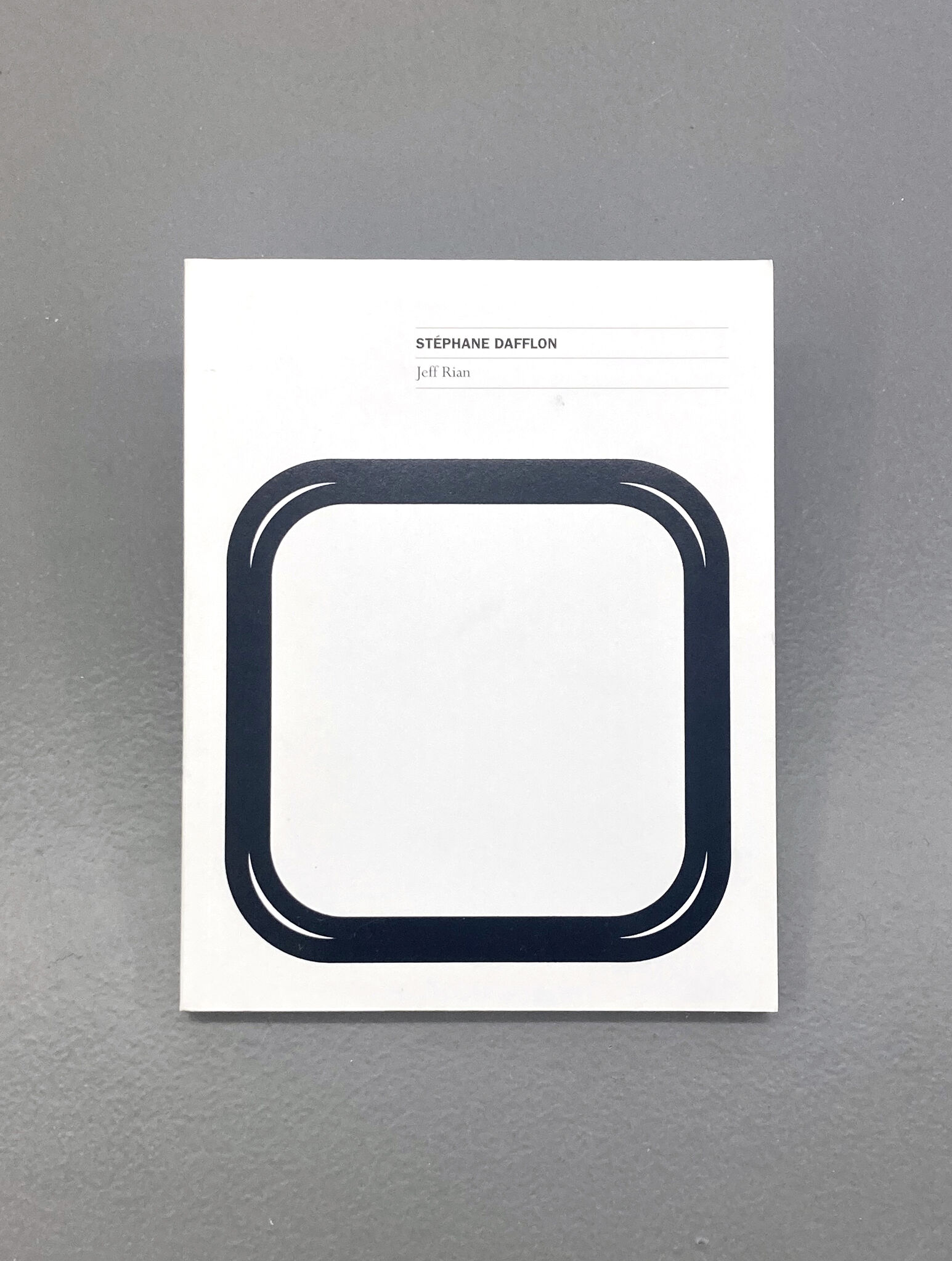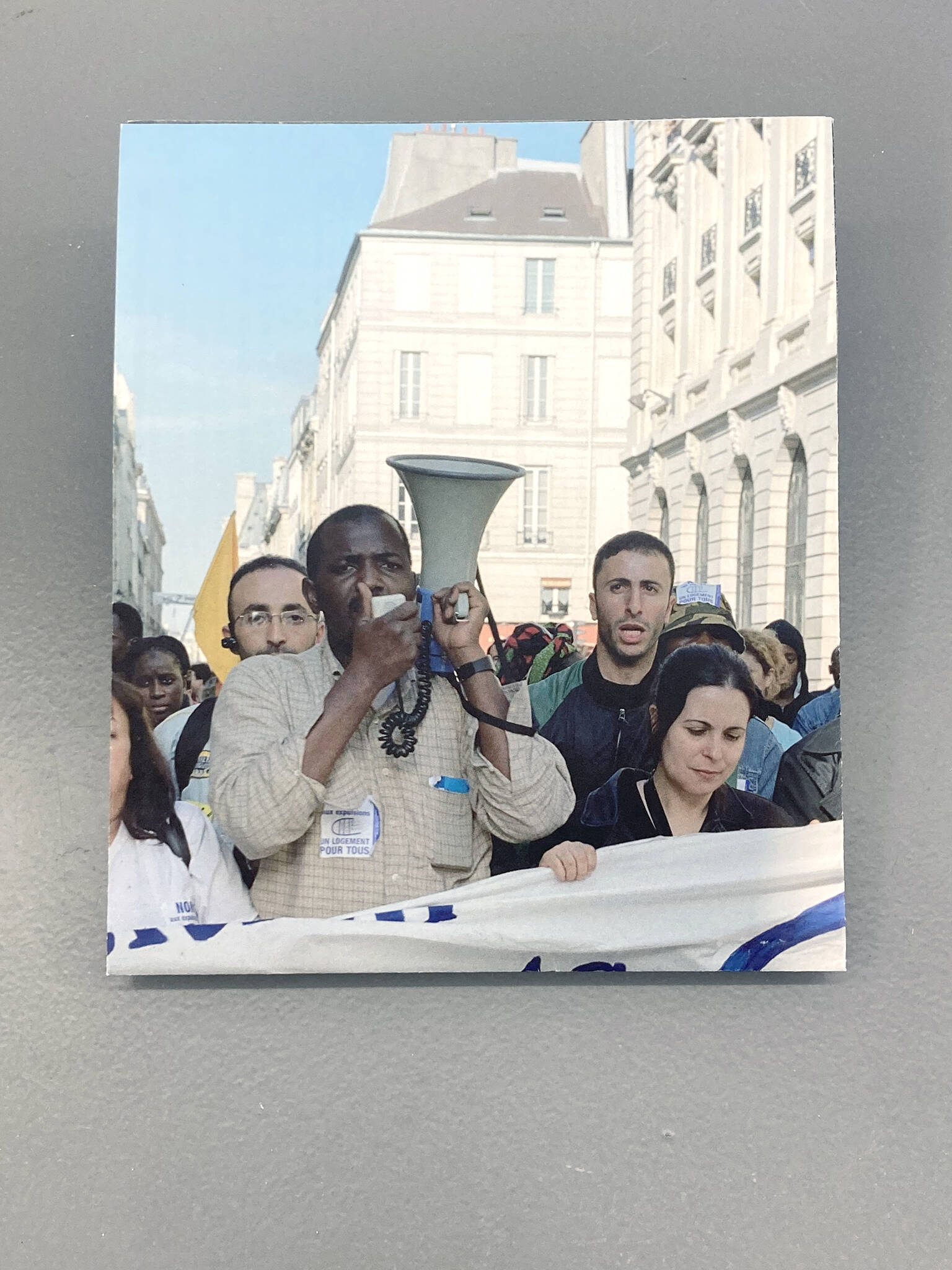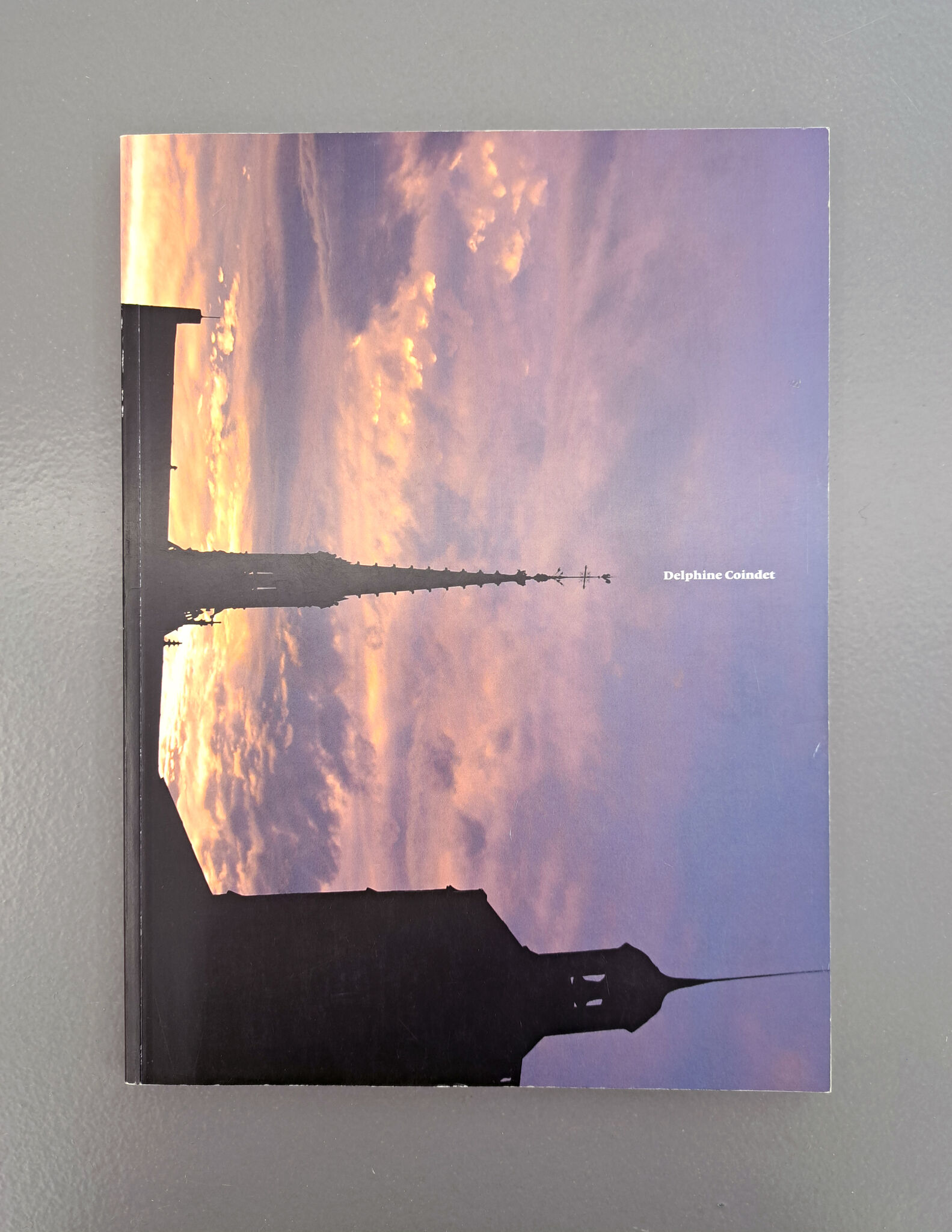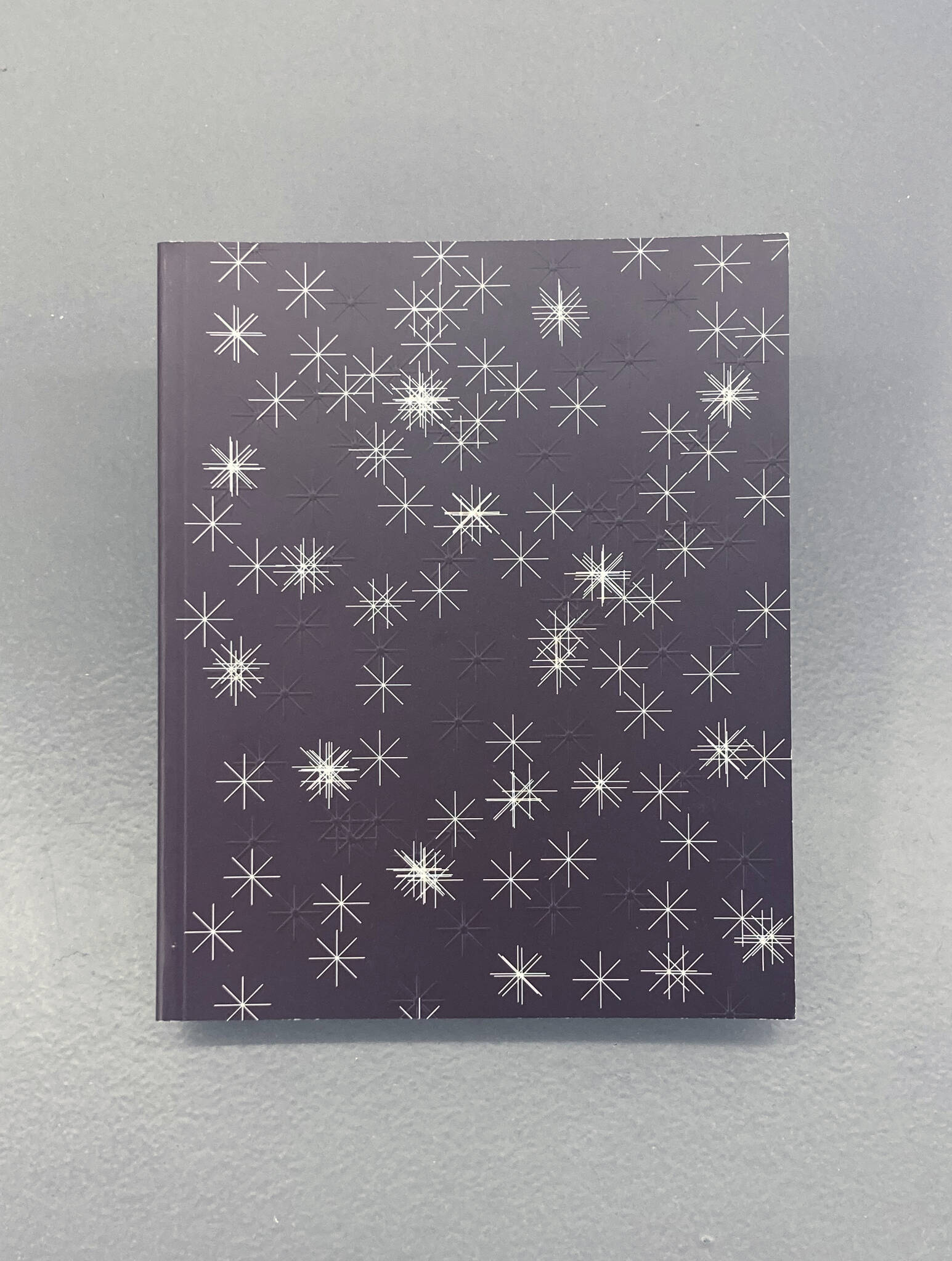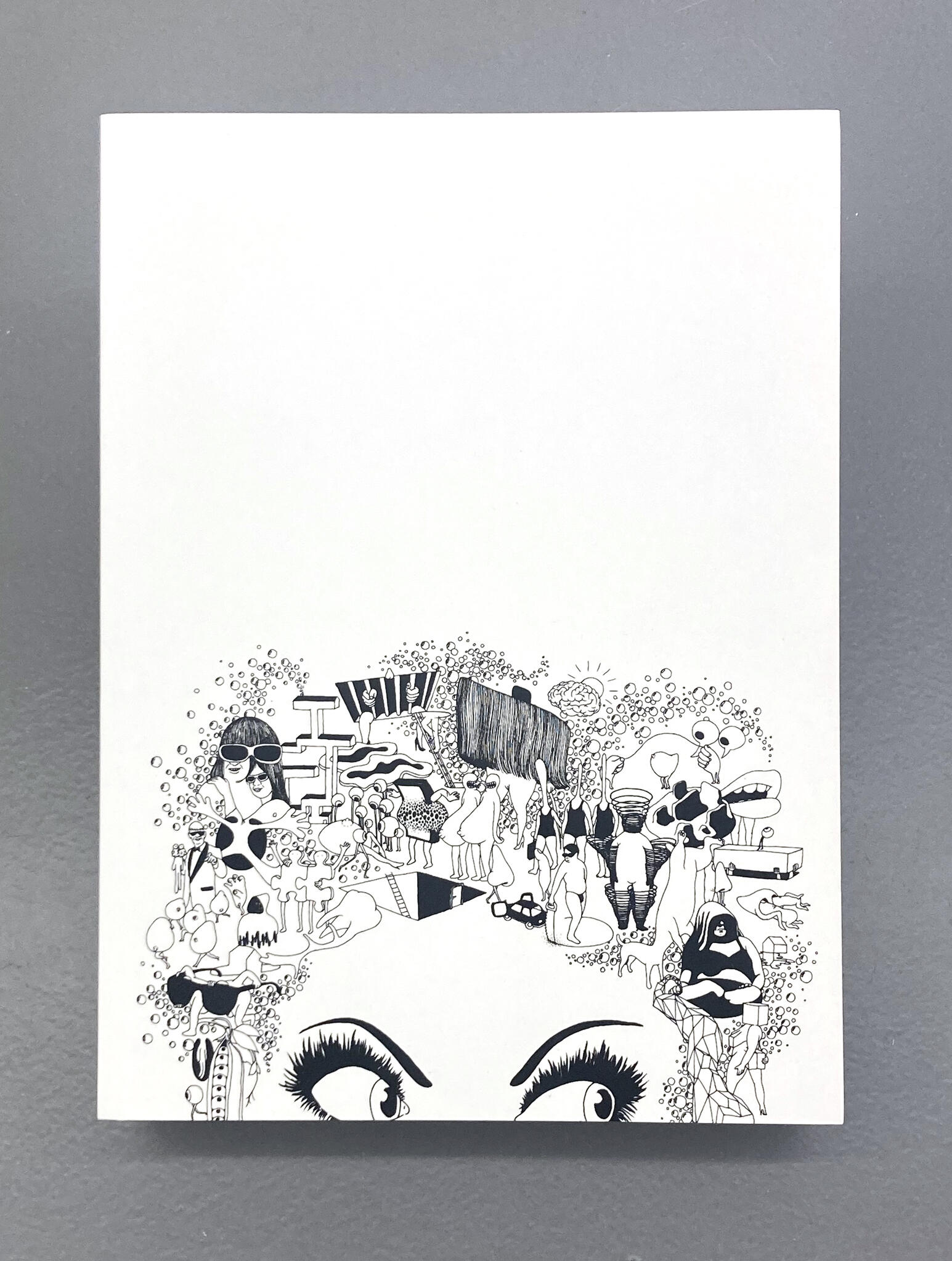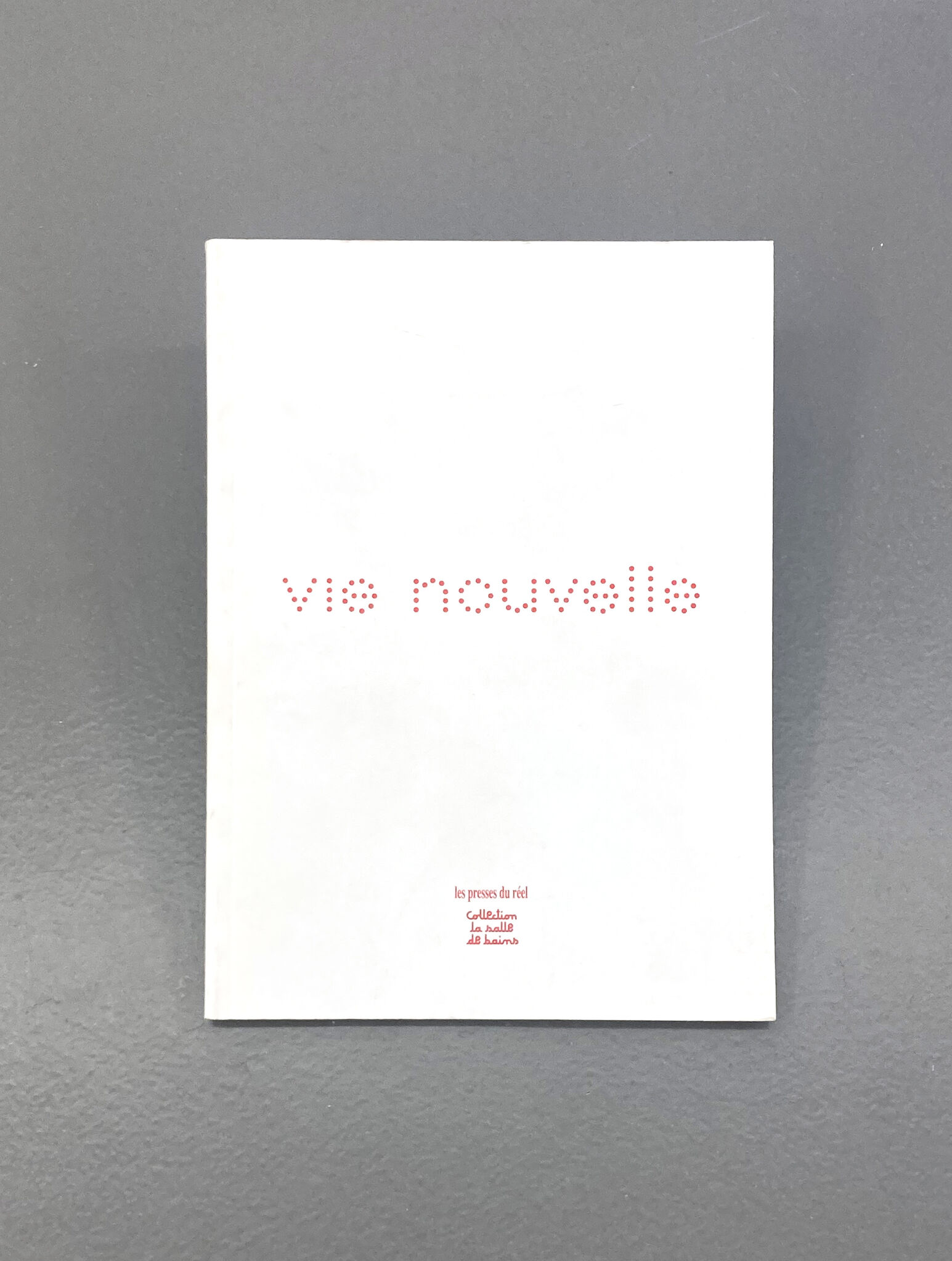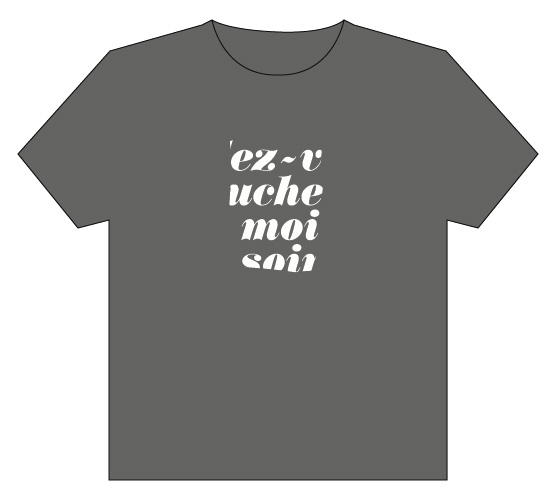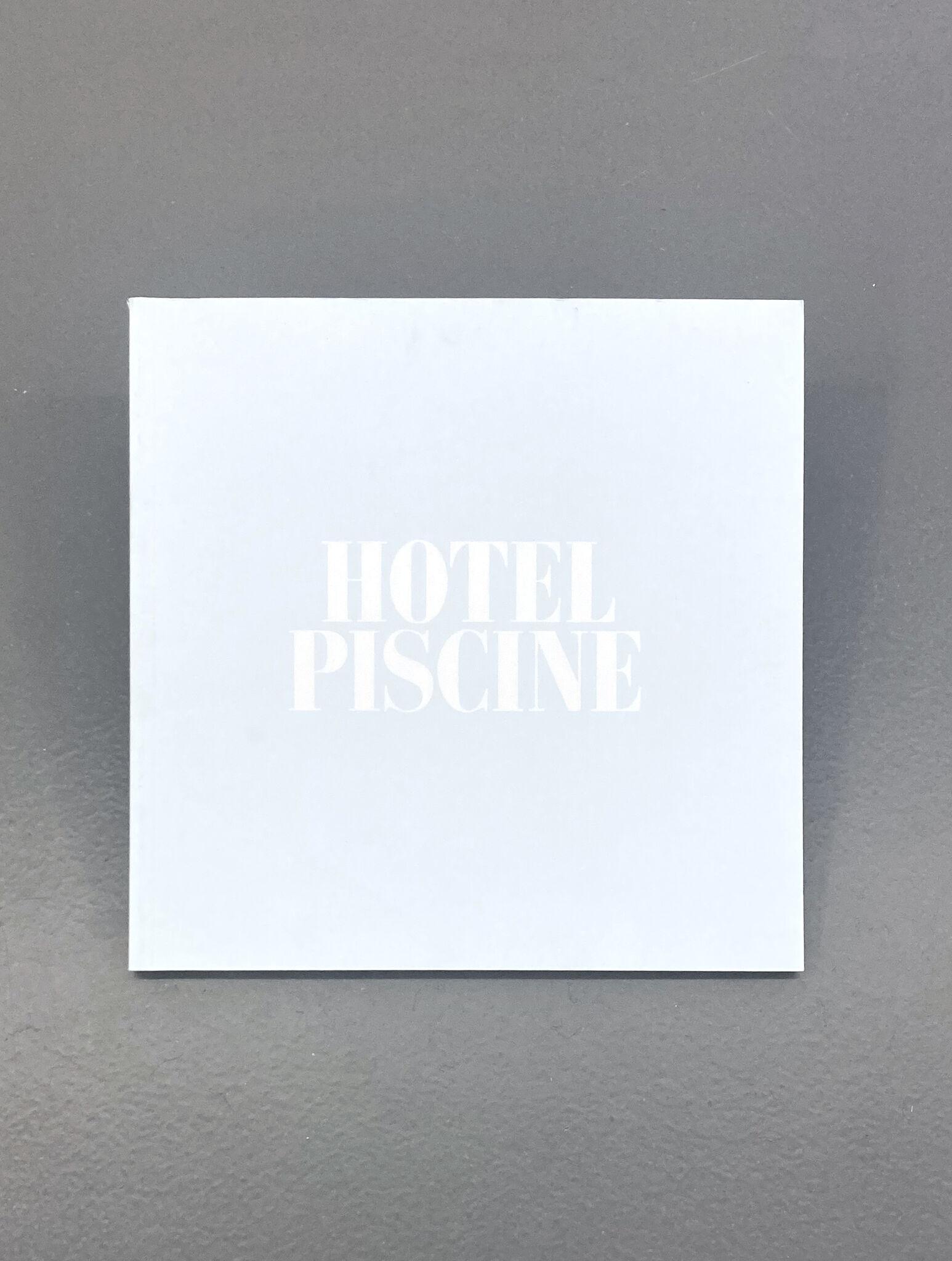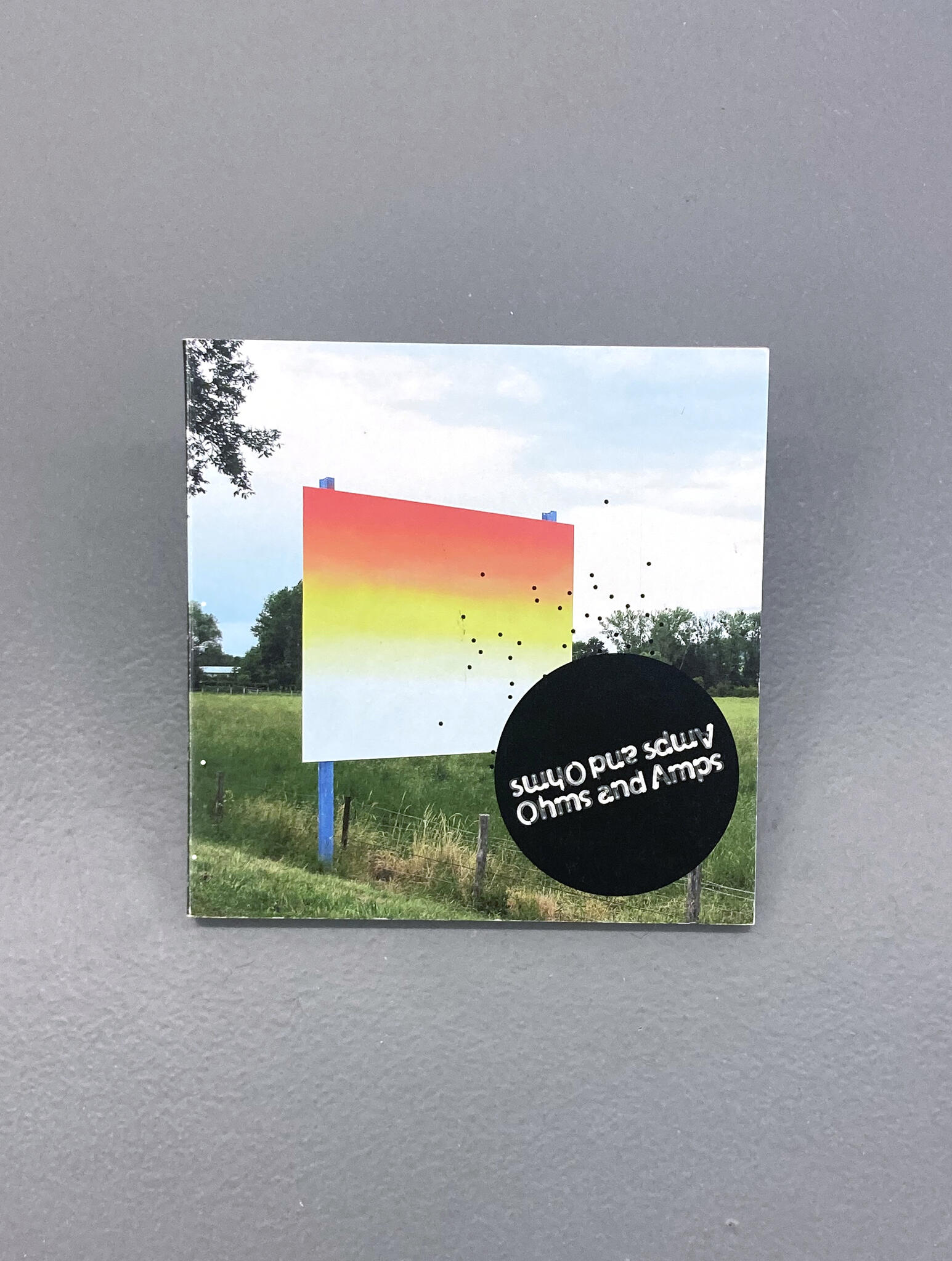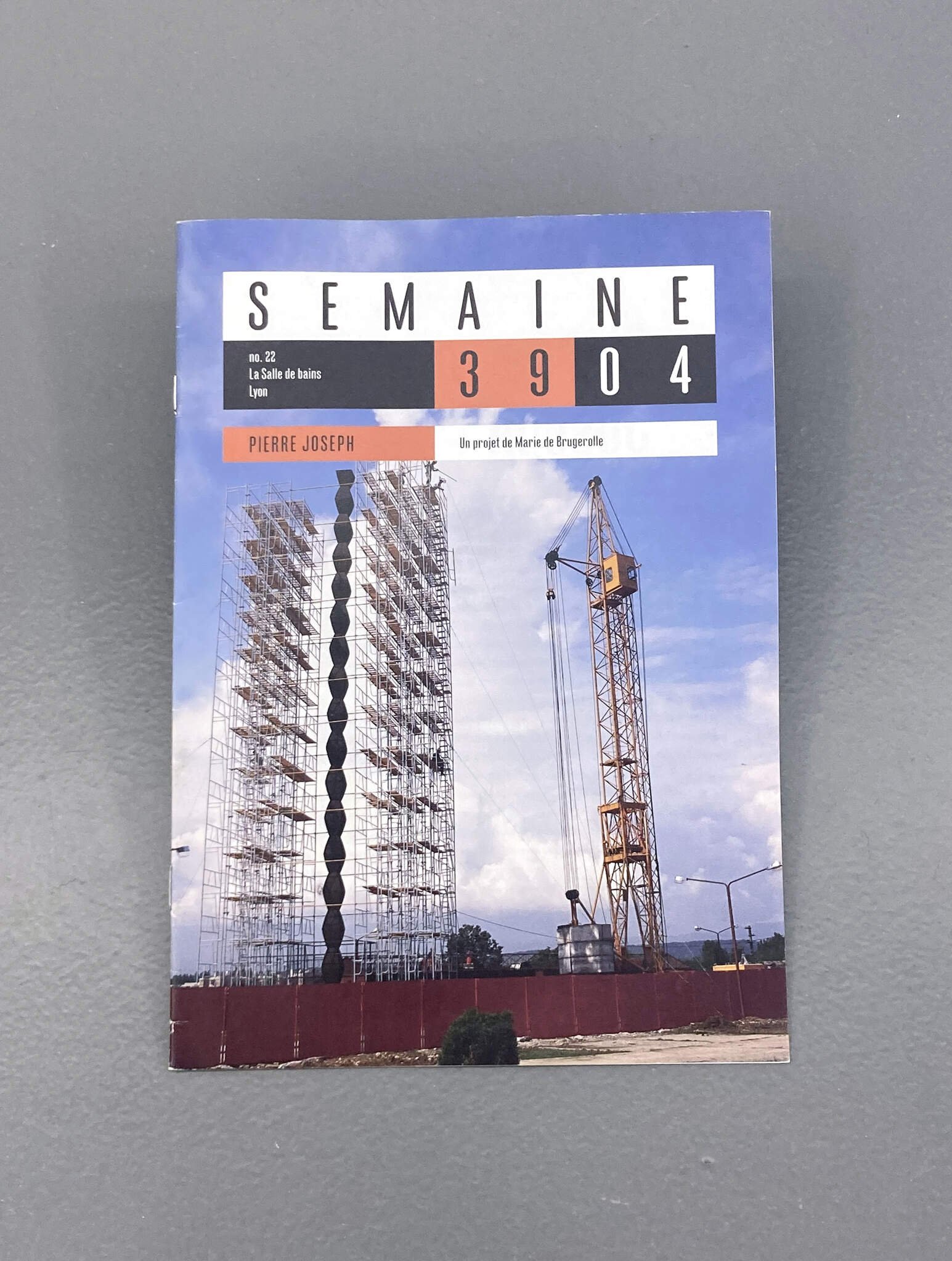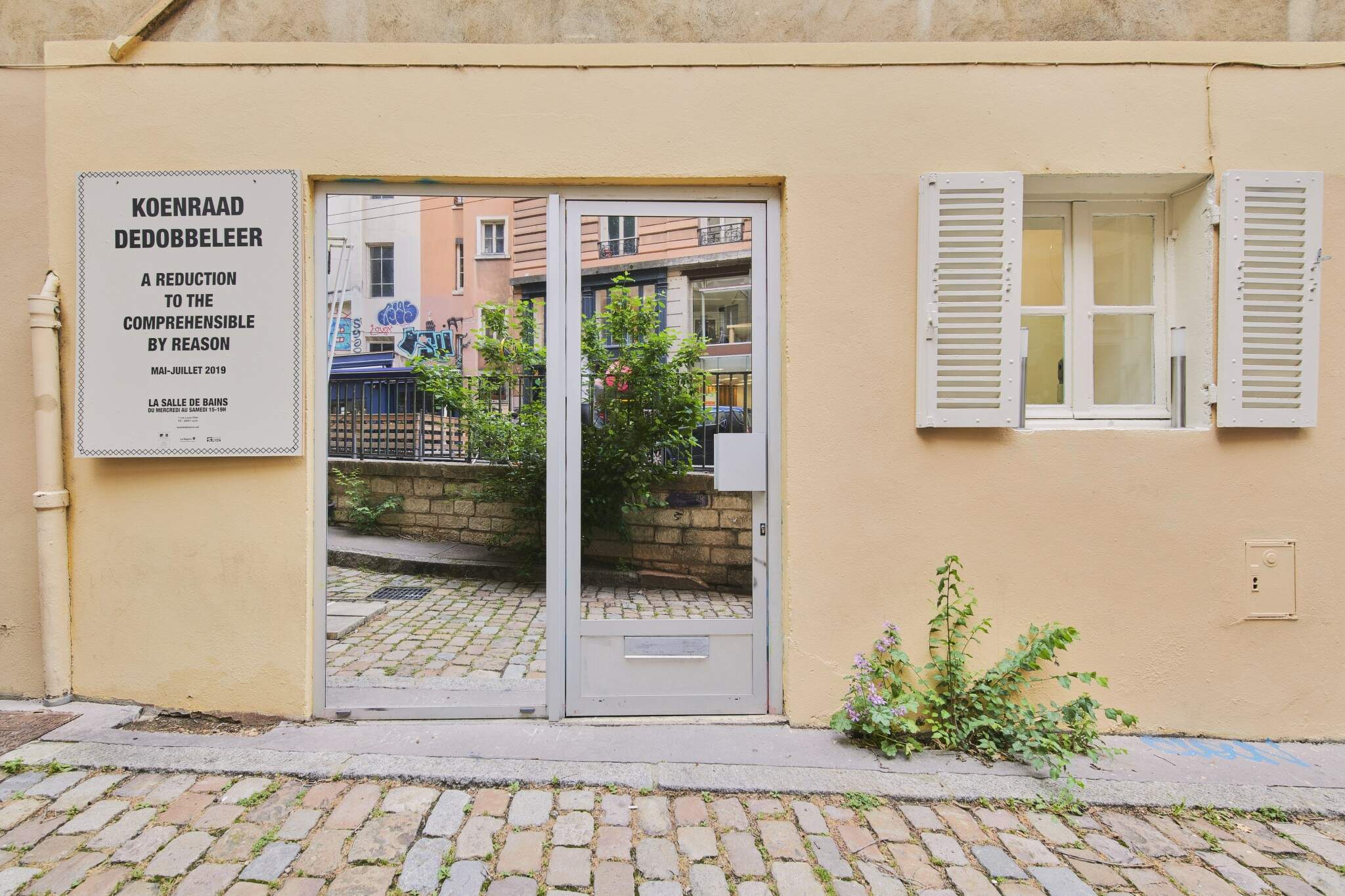
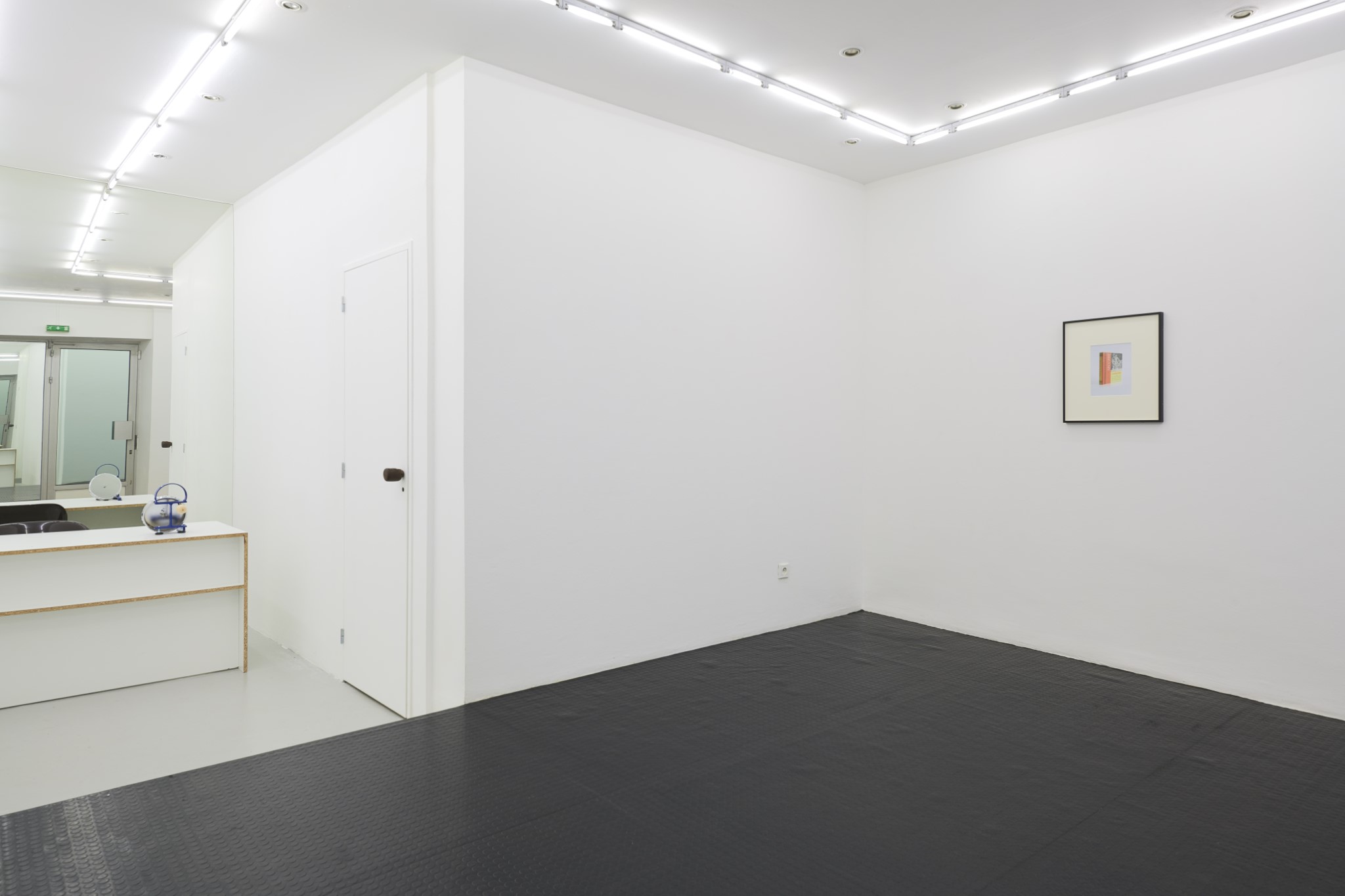
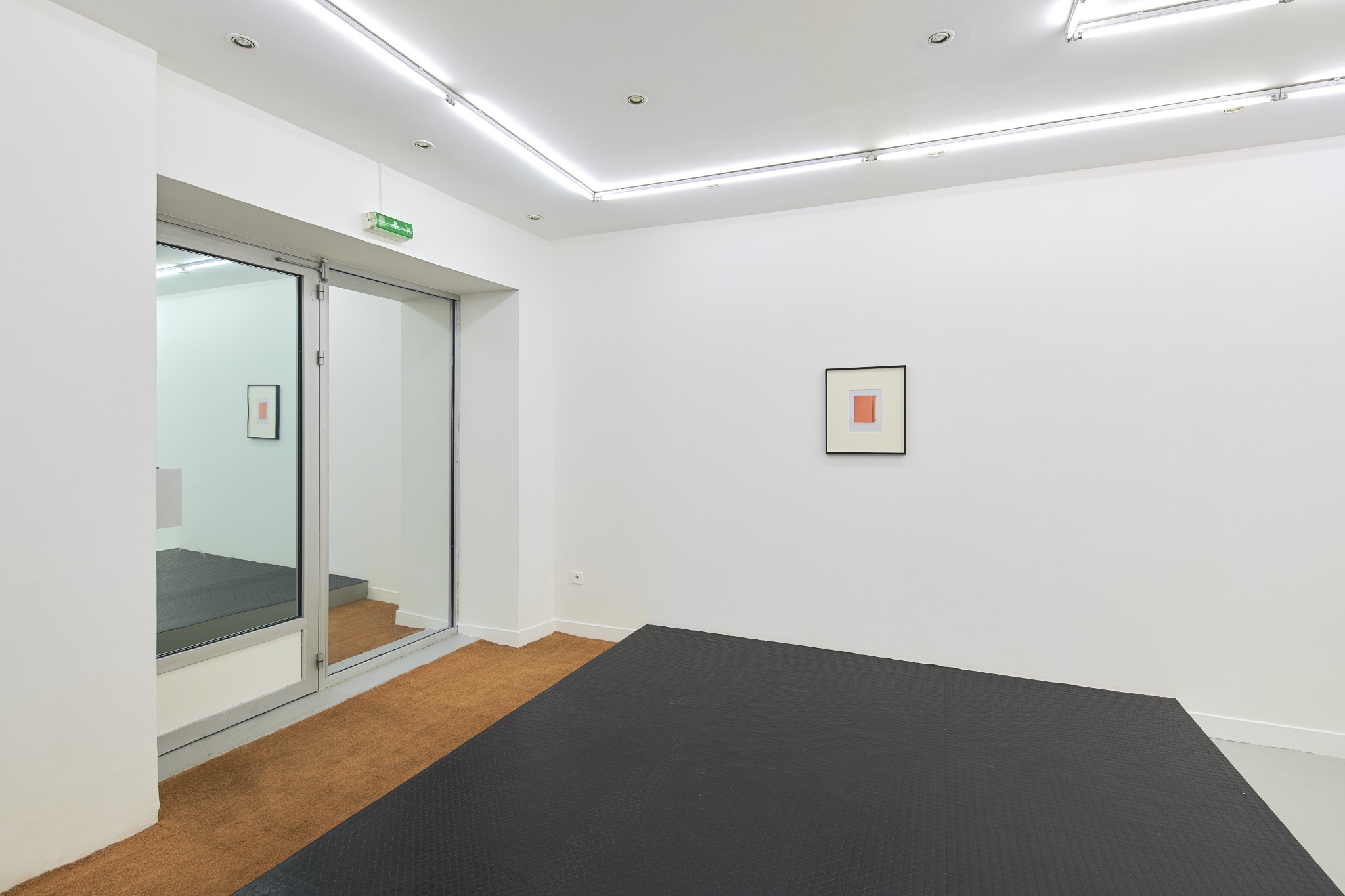
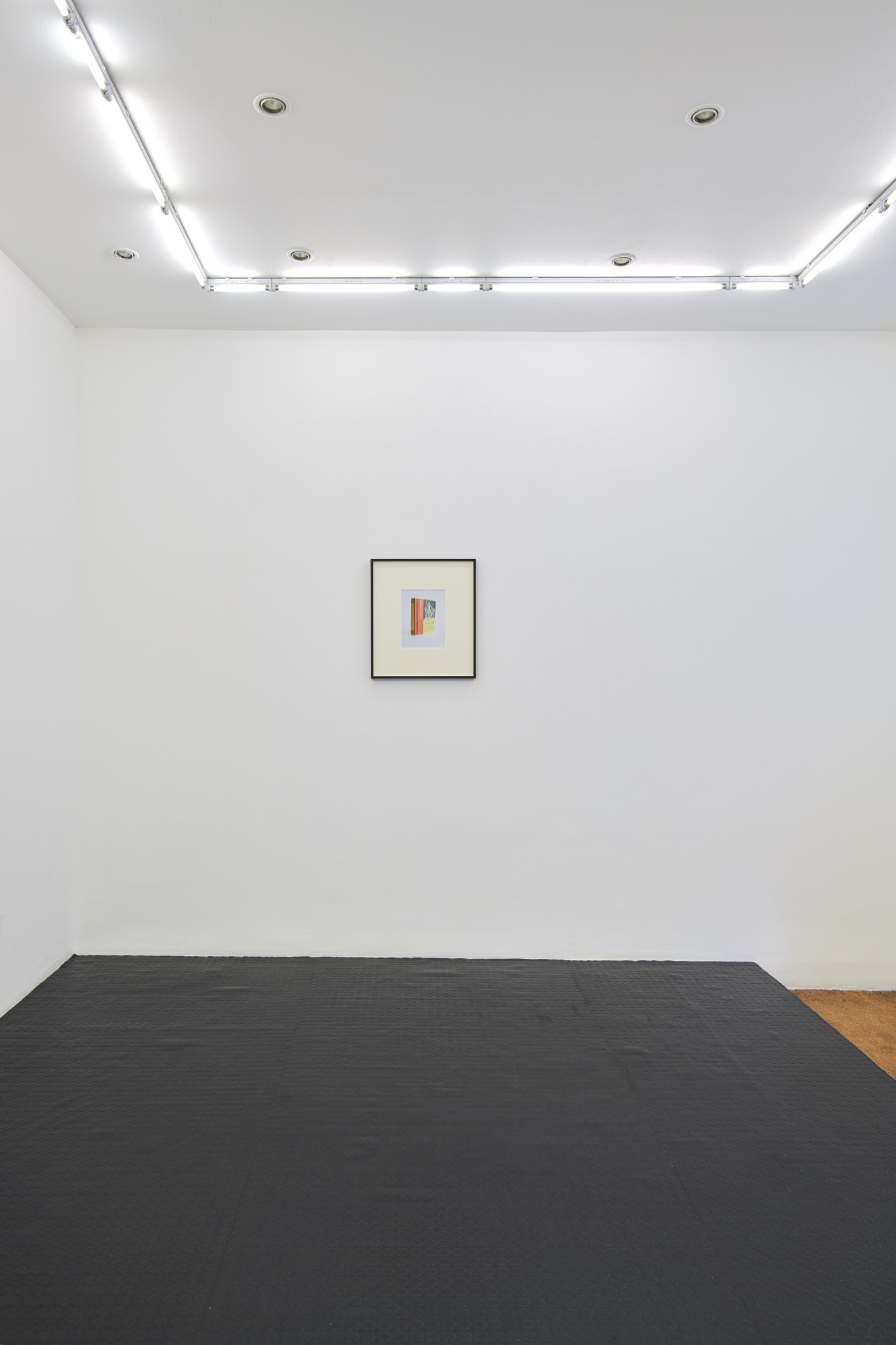
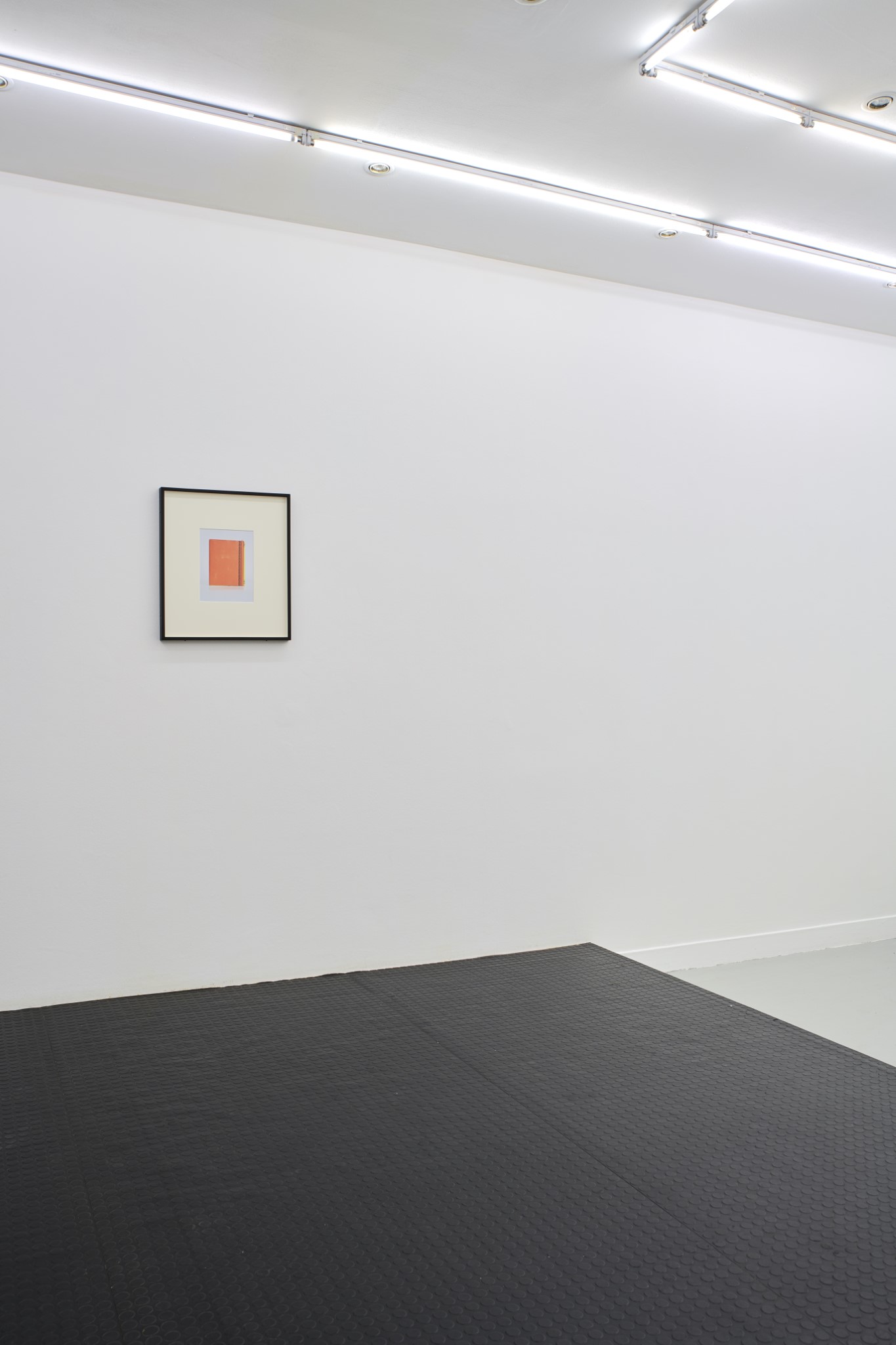
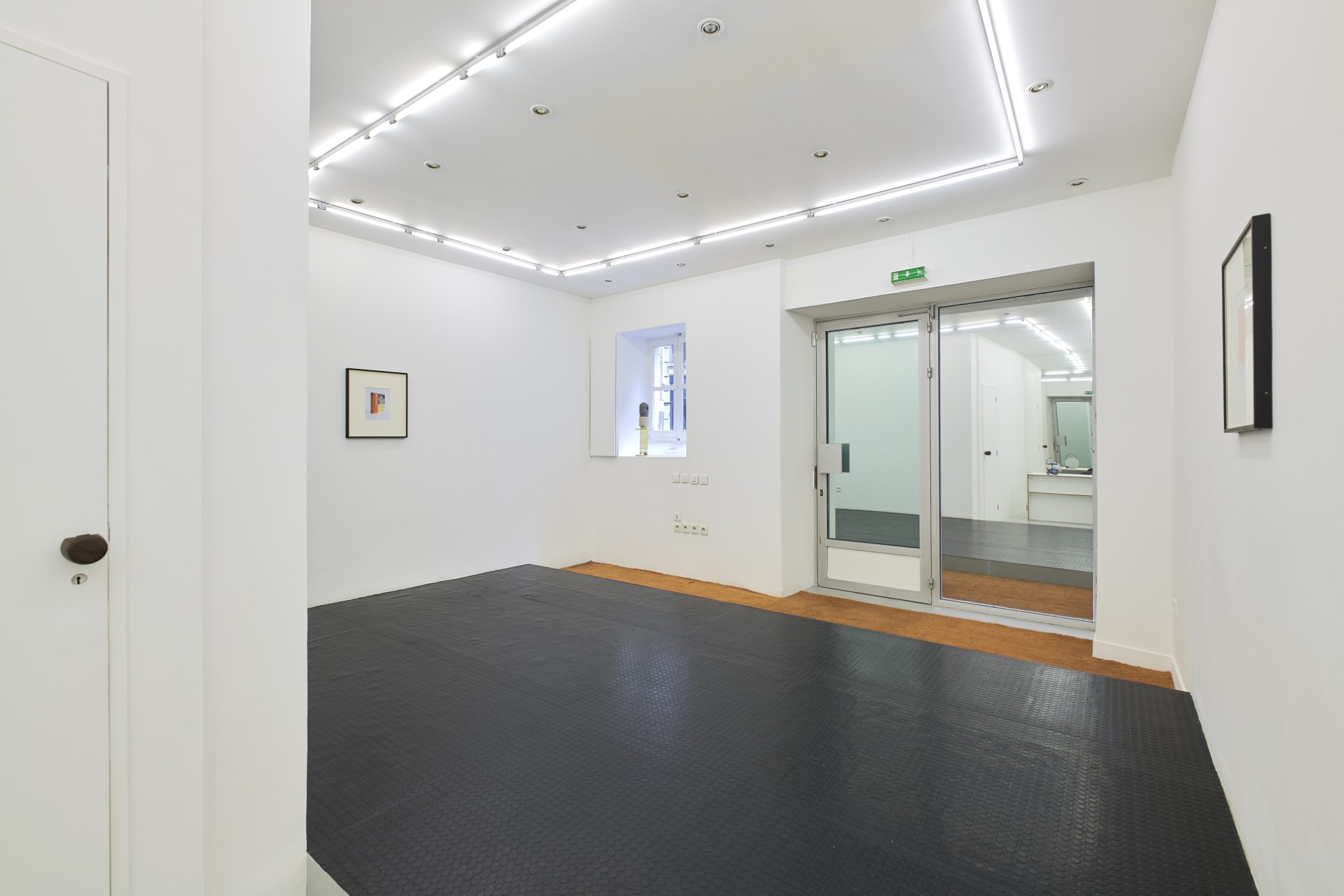
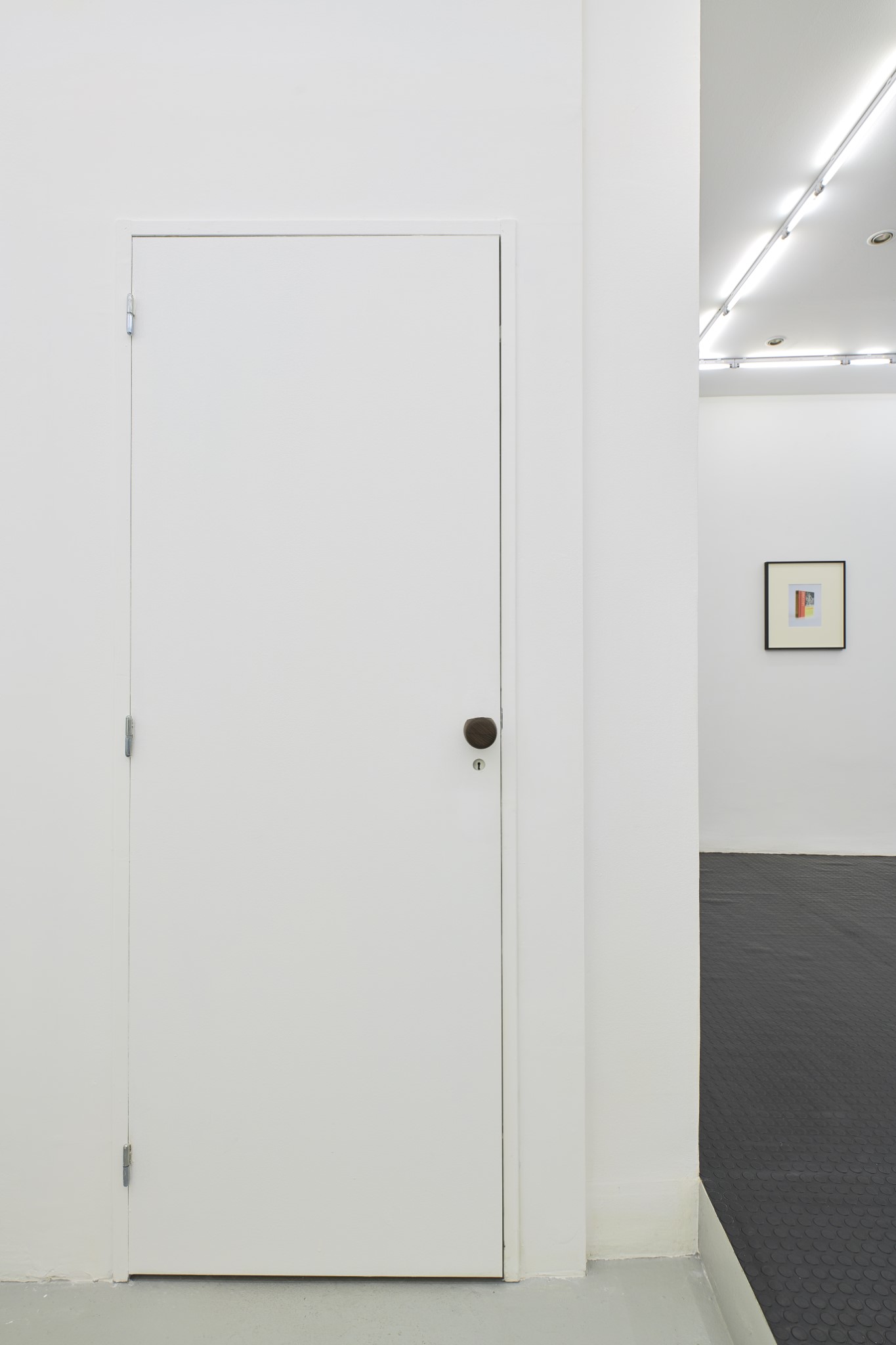
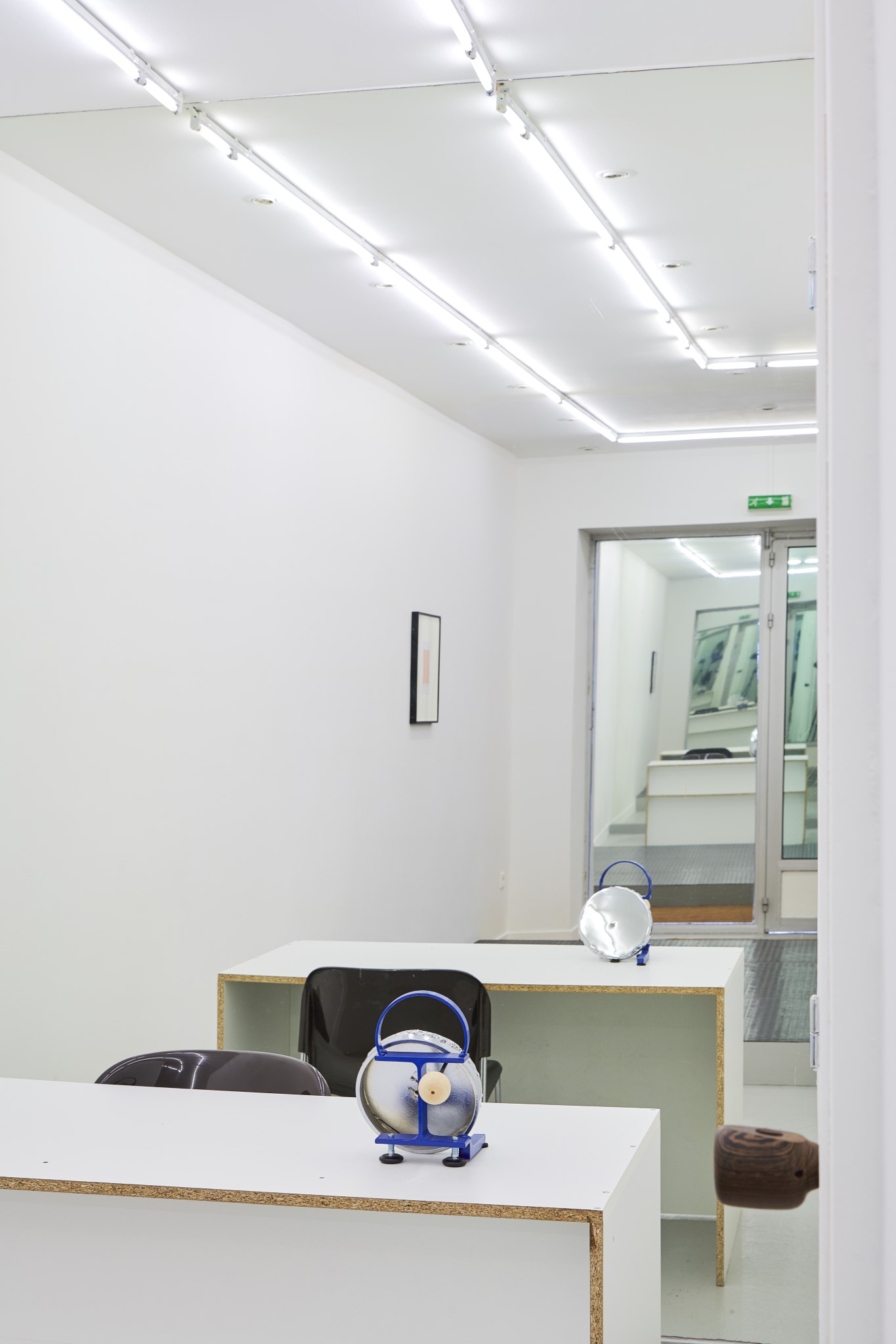
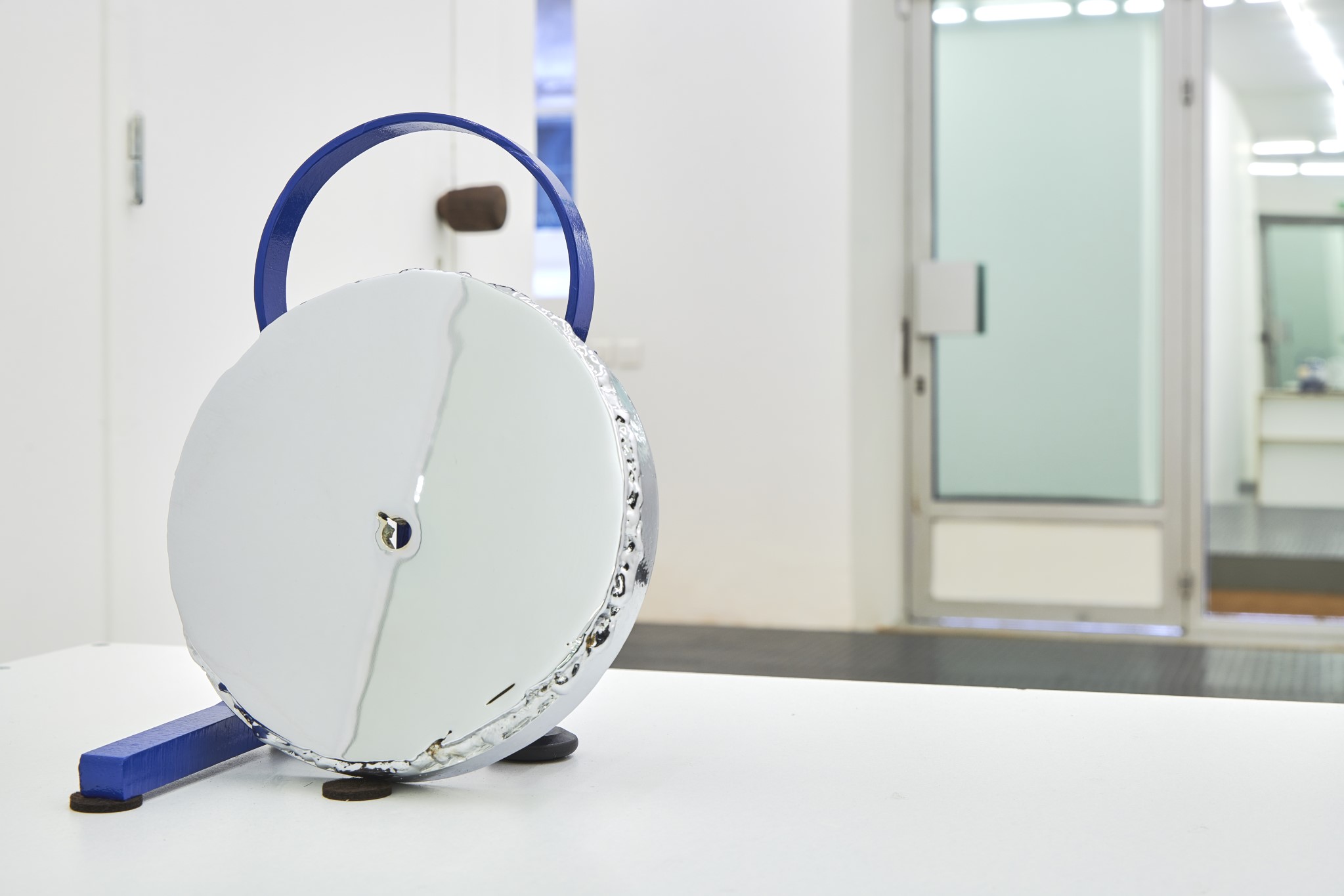
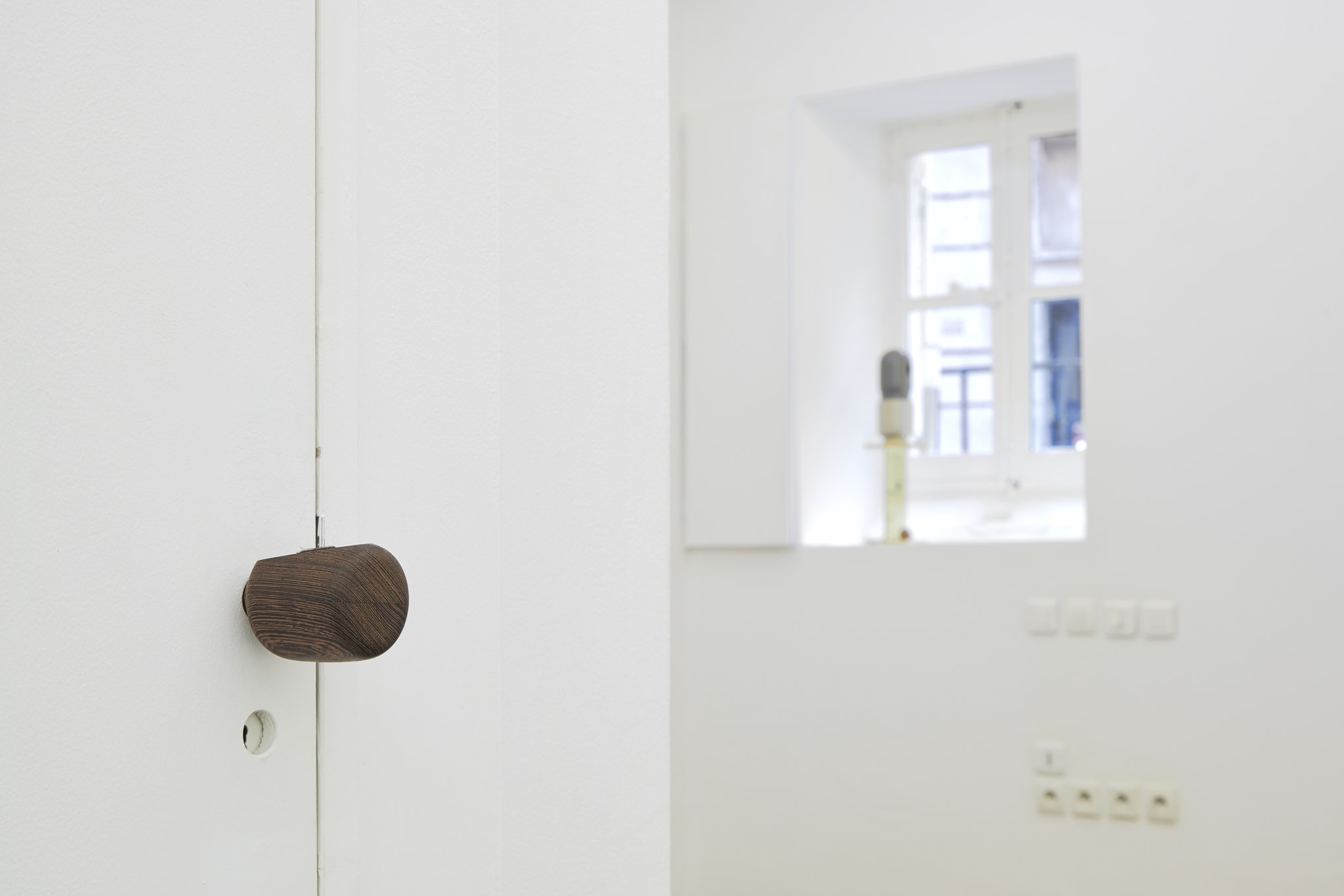
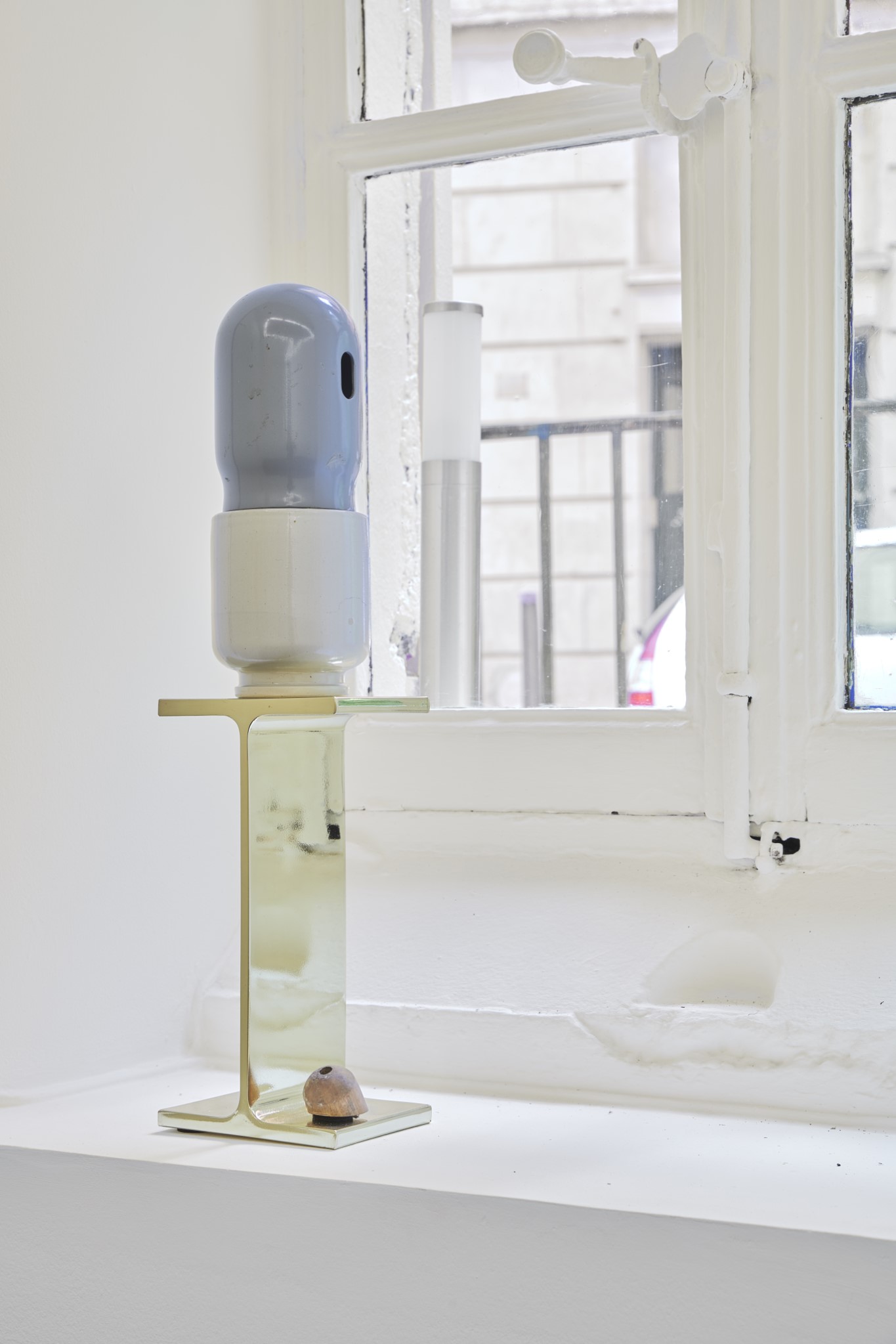
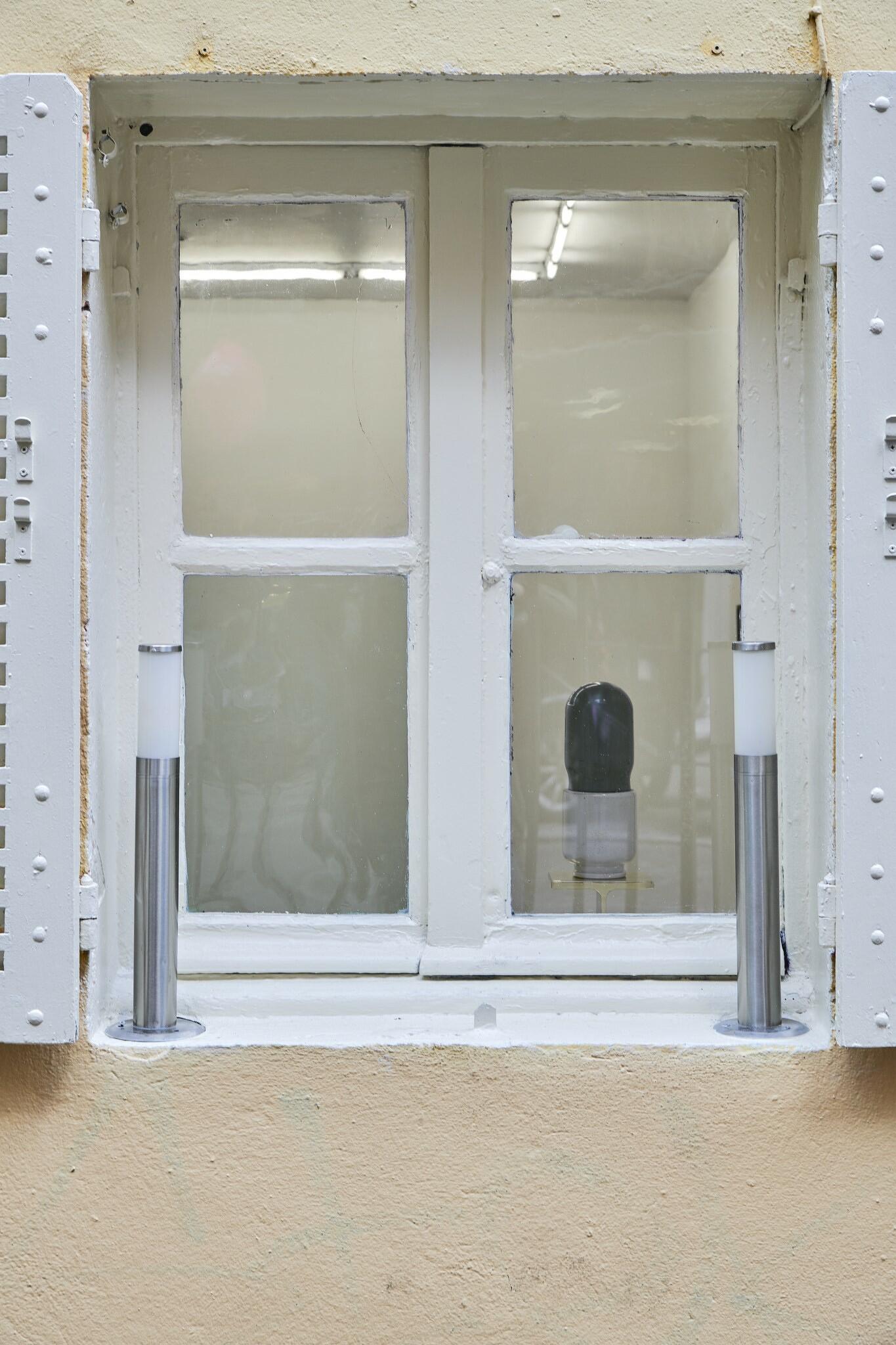
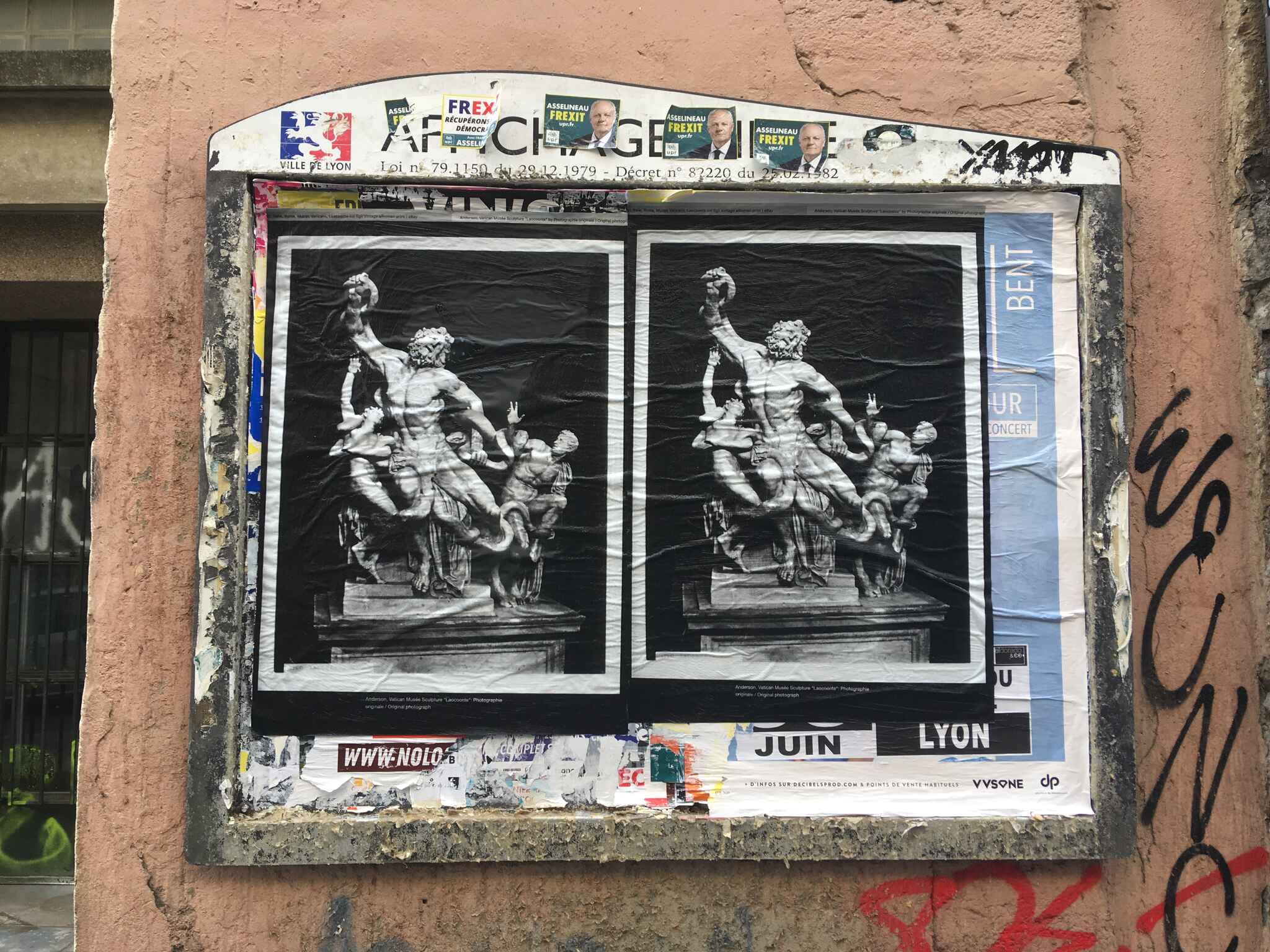
Koenraad Dedobbeleer, A Reduction To The Comprehensible By Reason, salle 2, la Salle de bains, Lyon du 7 au 22 juin 2019.
Photos : Jules Roeser
Photos : Jules Roeser
Koenraad Dedobbeleer, A Reduction To The Comprehensible By Reason, room 2, la Salle de bains, Lyon from 7 to 22 June 2019.
Photos : Jules Roeser
Photos : Jules Roeser
A Reduction To The Comprehensible By Reason - salle 2
Du 7 au 22 juin 2019From 7 to 22 June 2019
La première salle de l’exposition A Reduction to the Comprehensible by Reason de Koenraad Dedobbeleer à la Salle de bains commençait quelques jours avant son ouverture par l’apparition d’une image sur les panneaux d’affichage libre de la ville. Quant à l’espace d’exposition, il mordait sur la rue en reflétant son image – et par conséquent celle des visiteurs s’apprêtant à franchir la porte – dans un film miroir recouvrant la vitrine. À l’intérieur, l’espace a changé d’orientation : l’estrade s’est allongée pour se présenter perpendiculaire à la rue, entraînant dans son mouvement le paillasson qui s’étire d’un mur à l’autre. Le revêtement de sol de la petite réserve a migré sur l’estrade qui prend alors l’apparence d’une scène. Une porte a été installée entre l’espace d’exposition et sa partie technique.
Cette séparation avait pour fonction première de présenter une poignée de porte en ferronnerie parmi les trois œuvres exposées dans cette salle – et déjà une invitation à actionner un mécanisme, appréhender l’ergonomie de la sculpture ou son mouvement inhérent. Sur l’estrade – ou la scène, ou le socle –, deux autres œuvres se faisaient face. D’un côté, un relief mural d’inspiration modern De Stijl – mais attribuable au même design vernaculaire que la poignée de porte – intégrait un miroir dans lequel le visiteur, monté sur la scène ou le socle, pouvait voir le reflet de son visage. De l’autre côté, se trouvait accrochée au mur une photographie représentant le groupe sculpté du Laocoon. C’est le même motif, sous le même angle, le même état de la sculpture – avant la restauration du bras plié de Laocoon – que l’on trouvait sur l’image diffusée dans la rue pour une courte durée, avant d’être recouverte par d’autres colleurs d’affiches qui en furent peut-être les principaux destinataires. Mais ce n’était pas la même image, comme est semblable mais non identique celle qui a annoncé la salle 2 sur les mêmes murs de la même ville, quelques jours avant l’ouverture, et ainsi de celle qui annoncera la salle 3.
Si le Laocoon a été le support d’une théorie esthétique fondée sur la différence entre les arts, thème majeur de la modernité avec son corolaire, la recherche de pureté du médium, il est tout autant emblématique de l’histoire des relations entre la sculpture et la photographie dès son invention. Ces multiples images de la sculpture diffusées à l’adresse des amateurs à la fin du XIXe siècle sont autant d’idées de la sculpture, de reproductions d’une interprétation de la sculpture (dans une forme qui n’existe plus) pour offrir une expérience esthétique substitutive. Les images du Laocoon que produit Koenraad Dedobbeleer sont quant à elles des photographies de reproduction de ces photographies sur écran d’ordinateur, connecté à des sites de second marché. C’est autour de ces images impures d’une sculpture transitoire que s’articule cette dialectique du même et du différent ; c’est le parangon de la statuaire classique, conçue pour être regardée du seul point de vue frontal, mimant la nature dans un unique instant, qui est ici la charnière d’un mouvement inhérent, un point de bascule vers la perception de l’instabilité générale.
Cette séparation avait pour fonction première de présenter une poignée de porte en ferronnerie parmi les trois œuvres exposées dans cette salle – et déjà une invitation à actionner un mécanisme, appréhender l’ergonomie de la sculpture ou son mouvement inhérent. Sur l’estrade – ou la scène, ou le socle –, deux autres œuvres se faisaient face. D’un côté, un relief mural d’inspiration modern De Stijl – mais attribuable au même design vernaculaire que la poignée de porte – intégrait un miroir dans lequel le visiteur, monté sur la scène ou le socle, pouvait voir le reflet de son visage. De l’autre côté, se trouvait accrochée au mur une photographie représentant le groupe sculpté du Laocoon. C’est le même motif, sous le même angle, le même état de la sculpture – avant la restauration du bras plié de Laocoon – que l’on trouvait sur l’image diffusée dans la rue pour une courte durée, avant d’être recouverte par d’autres colleurs d’affiches qui en furent peut-être les principaux destinataires. Mais ce n’était pas la même image, comme est semblable mais non identique celle qui a annoncé la salle 2 sur les mêmes murs de la même ville, quelques jours avant l’ouverture, et ainsi de celle qui annoncera la salle 3.
Si le Laocoon a été le support d’une théorie esthétique fondée sur la différence entre les arts, thème majeur de la modernité avec son corolaire, la recherche de pureté du médium, il est tout autant emblématique de l’histoire des relations entre la sculpture et la photographie dès son invention. Ces multiples images de la sculpture diffusées à l’adresse des amateurs à la fin du XIXe siècle sont autant d’idées de la sculpture, de reproductions d’une interprétation de la sculpture (dans une forme qui n’existe plus) pour offrir une expérience esthétique substitutive. Les images du Laocoon que produit Koenraad Dedobbeleer sont quant à elles des photographies de reproduction de ces photographies sur écran d’ordinateur, connecté à des sites de second marché. C’est autour de ces images impures d’une sculpture transitoire que s’articule cette dialectique du même et du différent ; c’est le parangon de la statuaire classique, conçue pour être regardée du seul point de vue frontal, mimant la nature dans un unique instant, qui est ici la charnière d’un mouvement inhérent, un point de bascule vers la perception de l’instabilité générale.
The first gallery at La Salle de bains to present Koenraad Dedobbeleer’s A Reduction to the Comprehensible by Reason actually began to take shape several days before its official opening with the appearance of an image on free billboards around the city. The exhibition itself, moreover, started gnawing away at the street in front of the venue by reflecting its image – and therefore the image of any visitors as they approached the entry and made ready to cross the threshold – thanks to a mirror film applied to the double doors’ glass panes. Meanwhile, inside, the space itself had changed its orientation. The platform was lengthened, becoming perpendicular to the street while dragging along the doormat in its wake, which now stretches from one wall to the other. The floor covering of the tiny storeroom has spread and covers the platform, which has come to look like a stage. Finally, a door was installed between exhibition space and its technical area.
This separation was a way, first of all, to display a wrought-iron door handle, one of the three works shown in this gallery – and an invitation to activate a mechanism and comprehend the ergonomics of the sculpture and its inherent movement. On the platform – or the stage, or the pedestal – two other works are shown facing one another. On the one side, a wall relief of modern De Stijl inspiration – although attributable to the same design vocabulary as the door handle – incorporates a mirror in which visitors who mount the stage or pedestal will see their own faces reflected there.
On the other side, hanging on the wall, a photograph of the carved group of figures known as the Laocoön. It is the same motif, seen from the same angle, and shows the same state of the sculpture – before Laocoön’s bent arm was restored – that was seen in the image posted in streets around town for a short time before being covered over by other bill-posters, who may well have been the main audience for the image. But it wasn’t the same image, just as the image announcing Gallery 2 is similar but not identical, posted on the same walls of the same city a few days before the show opening – and likewise for the image that will announce Gallery 3.
If the Laocoön served as the support of an aesthetic theory based on the difference between the arts, a major theme of modernity along with its corollary, i.e., the search for the purity of the medium, it is just as emblematic of the history of sculpture’s relationship to photography from the very outset. Those multiple images of sculpture that were published in the late 19th century were as much ideas about sculpture as reproductions of an interpretation of sculpture (in a form that no longer exists), offering a vicarious aesthetic experience. As for the various images of the Laocoön that Koenraad Dedobbeleer has turned out, they are photographs of the reproductions of these photographs on the screen of a computer that is connected to sites in the secondary market. It is around these impure images of an impermanent sculpture that this dialectic of the same and the different is articulated; the paragon of classic statuary, designed to be viewed from a single straight-on point of view, imitating nature at a unique moment, is here the turning point of an inherent movement, a tipping point towards perceiving the general instability.
translation: John O'Toole
This separation was a way, first of all, to display a wrought-iron door handle, one of the three works shown in this gallery – and an invitation to activate a mechanism and comprehend the ergonomics of the sculpture and its inherent movement. On the platform – or the stage, or the pedestal – two other works are shown facing one another. On the one side, a wall relief of modern De Stijl inspiration – although attributable to the same design vocabulary as the door handle – incorporates a mirror in which visitors who mount the stage or pedestal will see their own faces reflected there.
On the other side, hanging on the wall, a photograph of the carved group of figures known as the Laocoön. It is the same motif, seen from the same angle, and shows the same state of the sculpture – before Laocoön’s bent arm was restored – that was seen in the image posted in streets around town for a short time before being covered over by other bill-posters, who may well have been the main audience for the image. But it wasn’t the same image, just as the image announcing Gallery 2 is similar but not identical, posted on the same walls of the same city a few days before the show opening – and likewise for the image that will announce Gallery 3.
If the Laocoön served as the support of an aesthetic theory based on the difference between the arts, a major theme of modernity along with its corollary, i.e., the search for the purity of the medium, it is just as emblematic of the history of sculpture’s relationship to photography from the very outset. Those multiple images of sculpture that were published in the late 19th century were as much ideas about sculpture as reproductions of an interpretation of sculpture (in a form that no longer exists), offering a vicarious aesthetic experience. As for the various images of the Laocoön that Koenraad Dedobbeleer has turned out, they are photographs of the reproductions of these photographs on the screen of a computer that is connected to sites in the secondary market. It is around these impure images of an impermanent sculpture that this dialectic of the same and the different is articulated; the paragon of classic statuary, designed to be viewed from a single straight-on point of view, imitating nature at a unique moment, is here the turning point of an inherent movement, a tipping point towards perceiving the general instability.
translation: John O'Toole
Liste des œuvres :
List of works :
The Future Projects Light, the Past Merely Casts Shadows, 2019
3 affiches, sérigraphie sur papier, diffusées dans la ville
100x70cm (chaque)
The Non-ideological Space Is not a Space that Is Free of Meaning and Order, 2019
tirage lambda encadré
49,5x43,7cm
Courtesy C L E A R I N G, New York, Bruxelles.
Remains a Difference Between Files and Facts, 2019
acier chromé, acier inoxydable, plastique et acier peint
19x28x16cm
Courtesy C L E A R I N G, New York, Bruxelles.
La cervelle est un organe étanche, 2018
wengé et métal
18x6,5cm
Courtesy de l’artiste et MANIERA, Bruxelles.
Aspersive, 2019
tirage lambda encadré
49,5x43,6cm
Courtesy C L E A R I N G, New York, Bruxelles.
Real Wars Take Place Between Data Flows, 2019
acier plaqué laiton, céramique, bois et acier peint
15x55x15cm
Courtesy C L E A R I N G, New York, Bruxelles.
Interventions architecturales : podium, porte, paillasson et vitrine miroitante.
3 affiches, sérigraphie sur papier, diffusées dans la ville
100x70cm (chaque)
The Non-ideological Space Is not a Space that Is Free of Meaning and Order, 2019
tirage lambda encadré
49,5x43,7cm
Courtesy C L E A R I N G, New York, Bruxelles.
Remains a Difference Between Files and Facts, 2019
acier chromé, acier inoxydable, plastique et acier peint
19x28x16cm
Courtesy C L E A R I N G, New York, Bruxelles.
La cervelle est un organe étanche, 2018
wengé et métal
18x6,5cm
Courtesy de l’artiste et MANIERA, Bruxelles.
Aspersive, 2019
tirage lambda encadré
49,5x43,6cm
Courtesy C L E A R I N G, New York, Bruxelles.
Real Wars Take Place Between Data Flows, 2019
acier plaqué laiton, céramique, bois et acier peint
15x55x15cm
Courtesy C L E A R I N G, New York, Bruxelles.
Interventions architecturales : podium, porte, paillasson et vitrine miroitante.
The Future Projects Light, the Past Merely Casts Shadows, 2019
3 posters, silkscreen on paper, posted around town
100 x 70 cm (each)
The Non-ideological Space Is not a Space that Is Free of Meaning and Order, 2019
framed lambda print
49.5 x 43.7cm
Courtesy C L E A R I N G, New York, Brussels.
Remains a Difference Between Files and Facts, 2019
chrome steel, stainless steel, plastic and painted steel
19x28x16cm
Courtesy C L E A R I N G, New York, Brussels.
La cervelle est un organe étanche, 2018
wenge and metal
18x6.5cm
Courtesy of the artist and MANIERA, Brussels.
Aspersive, 2019
framed lambda print
49.5x43.6cm
Courtesy C L E A R I N G, New York, Brussels.
Real Wars Take Place Between Data Flows, 2019
brass-plated steel, ceramic, wood, and painted steel
15x55x15cm
Courtesy C L E A R I N G, New York, Brussels.
Architectural interventions: podium, door, doormat, and mirrored glass panes.
3 posters, silkscreen on paper, posted around town
100 x 70 cm (each)
The Non-ideological Space Is not a Space that Is Free of Meaning and Order, 2019
framed lambda print
49.5 x 43.7cm
Courtesy C L E A R I N G, New York, Brussels.
Remains a Difference Between Files and Facts, 2019
chrome steel, stainless steel, plastic and painted steel
19x28x16cm
Courtesy C L E A R I N G, New York, Brussels.
La cervelle est un organe étanche, 2018
wenge and metal
18x6.5cm
Courtesy of the artist and MANIERA, Brussels.
Aspersive, 2019
framed lambda print
49.5x43.6cm
Courtesy C L E A R I N G, New York, Brussels.
Real Wars Take Place Between Data Flows, 2019
brass-plated steel, ceramic, wood, and painted steel
15x55x15cm
Courtesy C L E A R I N G, New York, Brussels.
Architectural interventions: podium, door, doormat, and mirrored glass panes.
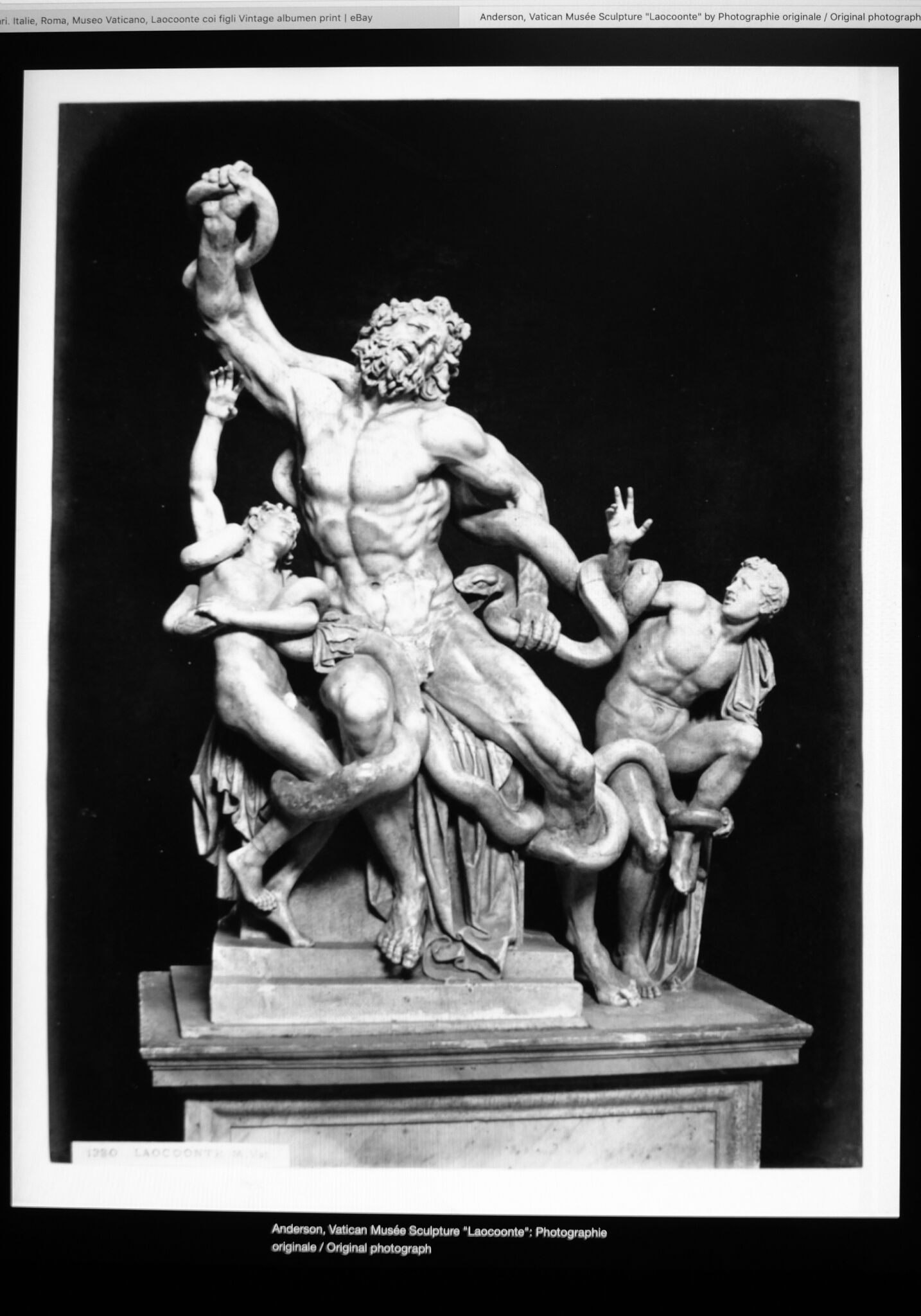
A Reduction To The Comprehensible By Reason - salle 2, 2019
affiche
Koenraad Dedobbeleer (1975, Belgique) vit et travaille à Bruxelles. Aujourd’hui représenté par les galeries ProjecteSD, Barcelone et Mai36, Zurich, il a réalisé ces dernières années de nombreuses expositions personnelles dont On My Own Ignorance and That of Many Others, C L E A R I N G, Bruxelles, Plastik, Gallery of Material Culture, Kunstmuseum Winterthur, Kunststoff, Gallery of Material Culture, Wiels, Bruxelles, There Is No Real Life, Only The Story Of The Life We Are Currently Living, ProjecteSD, Barcelone, Workmanship of Certainty, le Crédac, Ivry-sur-Seine; As Long as it Is Striven After, it Goes on Expanding, CAC, Vilnius et Sache, Gallery of Material Culture, Kunstverein Hannover.
Koenraad Dedobbeleer (1975, Belgium) lives and works in Brussels.
Currently represented by the galleries ProjecteSD, Barcelona; and Mai36, Zurich. In recent years he has shown his work in a number of solo exhibitions, including On My Own Ignorance and That of Many Others, C L E A R I N G, Brussels; Plastik, Gallery of Material Culture, Kunstmuseum Winterthur; Kunststoff, Gallery of Material Culture, Wiels, Brussels; There Is No Real Life, Only The Story Of The Life We Are Currently Living, ProjecteSD, Barcelona; Workmanship of Certainty, Le Crédac, Ivry-sur-Seine; As Long as It Is Striven After, It Goes on Expanding, CAC, Vilnius, and Sache, Gallery of Material Culture, Kunstverein Hannover.
Currently represented by the galleries ProjecteSD, Barcelona; and Mai36, Zurich. In recent years he has shown his work in a number of solo exhibitions, including On My Own Ignorance and That of Many Others, C L E A R I N G, Brussels; Plastik, Gallery of Material Culture, Kunstmuseum Winterthur; Kunststoff, Gallery of Material Culture, Wiels, Brussels; There Is No Real Life, Only The Story Of The Life We Are Currently Living, ProjecteSD, Barcelona; Workmanship of Certainty, Le Crédac, Ivry-sur-Seine; As Long as It Is Striven After, It Goes on Expanding, CAC, Vilnius, and Sache, Gallery of Material Culture, Kunstverein Hannover.
La Salle de bains reçoit le soutien du Ministère de la Culture DRAC Auvergne-Rhône-Alpes,
de la Région Auvergne-Rhône-Alpes et de la Ville de Lyon.
de la Région Auvergne-Rhône-Alpes et de la Ville de Lyon.
